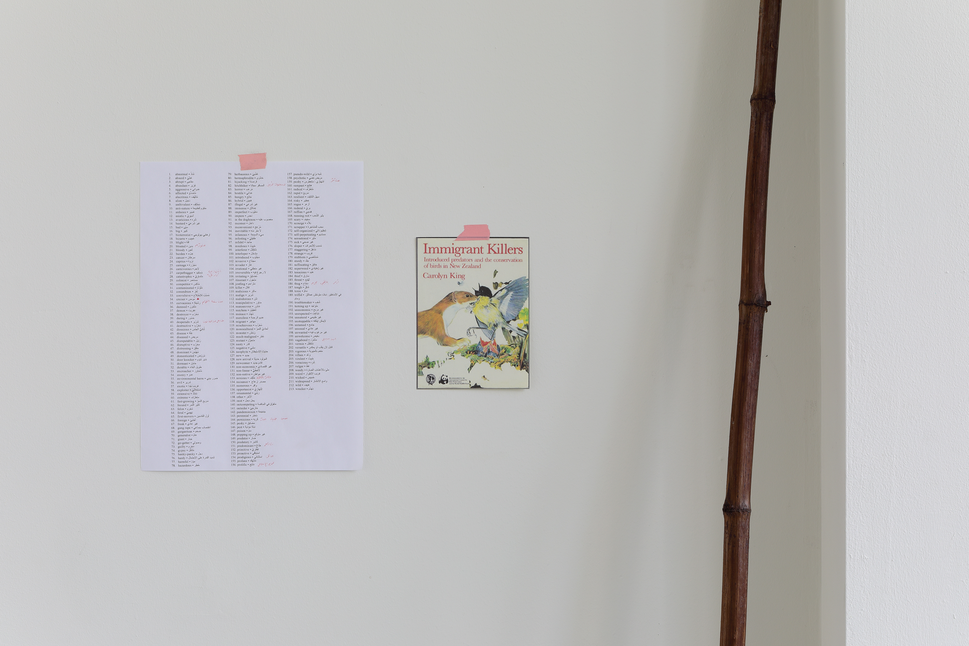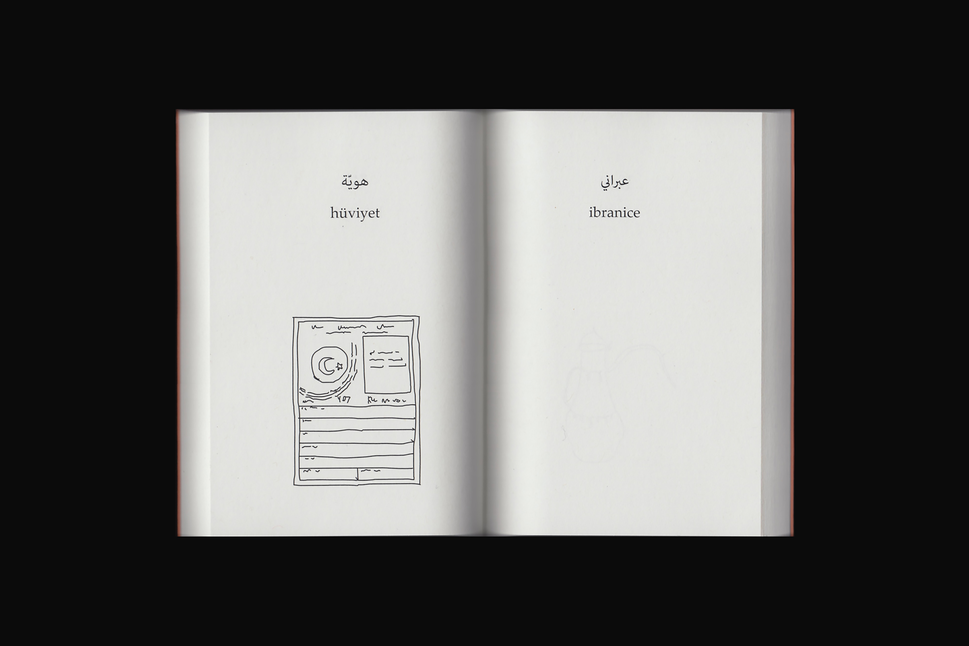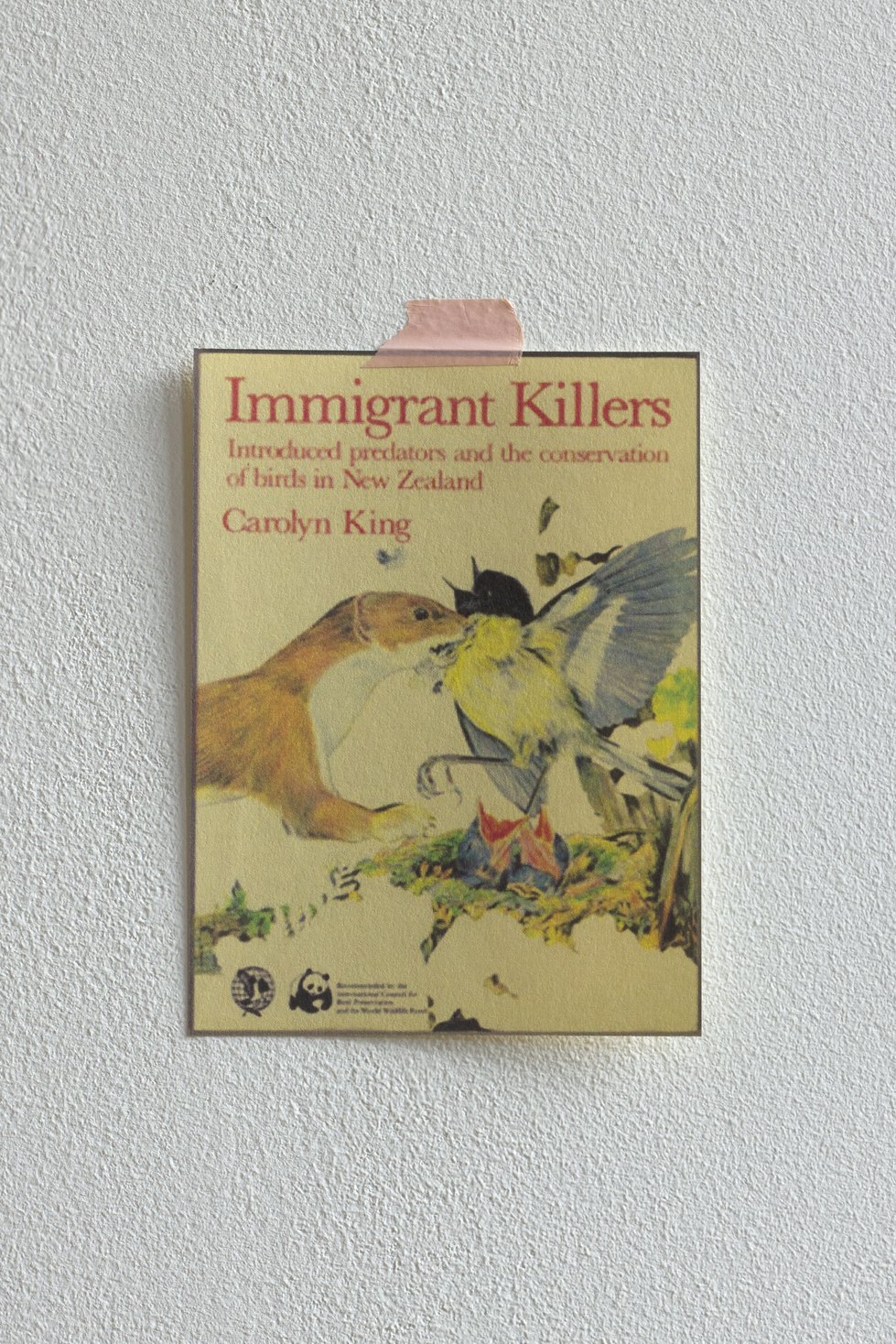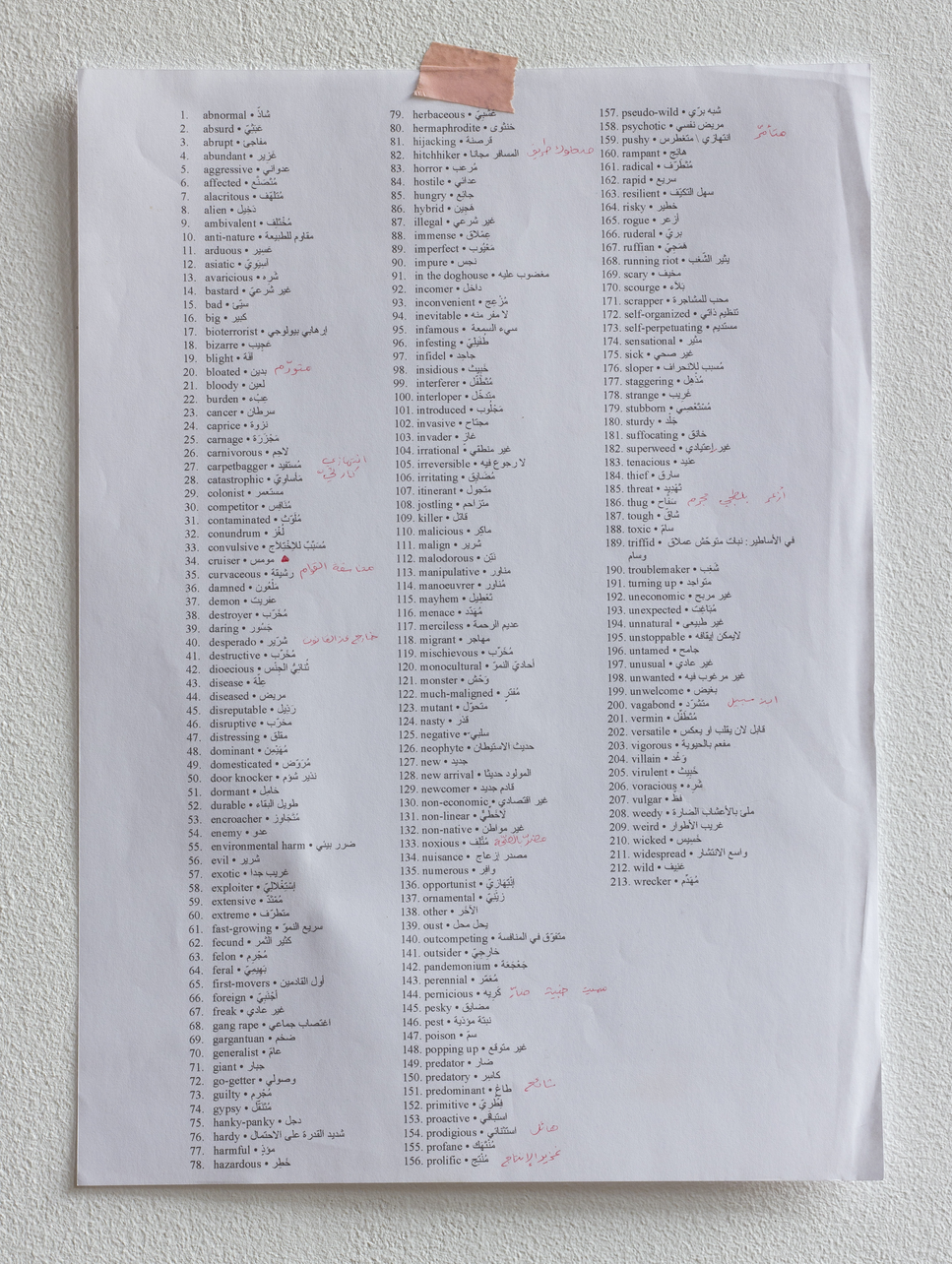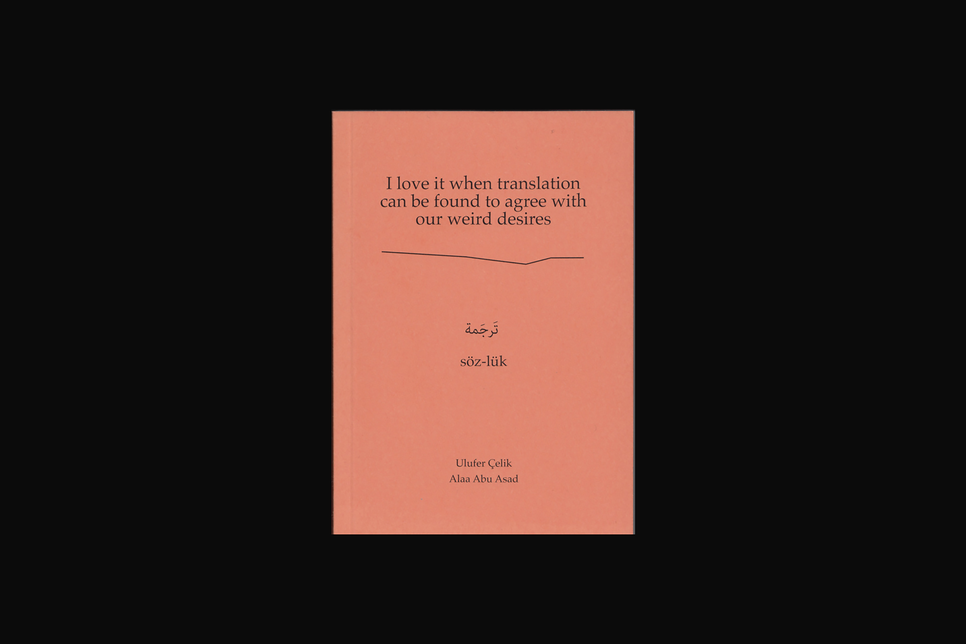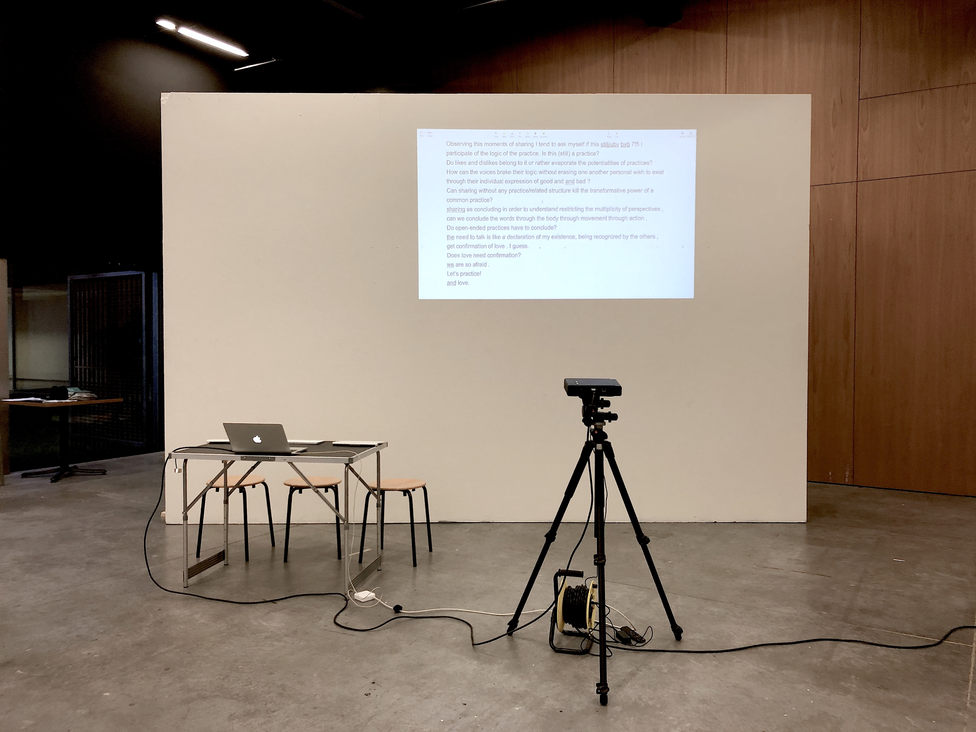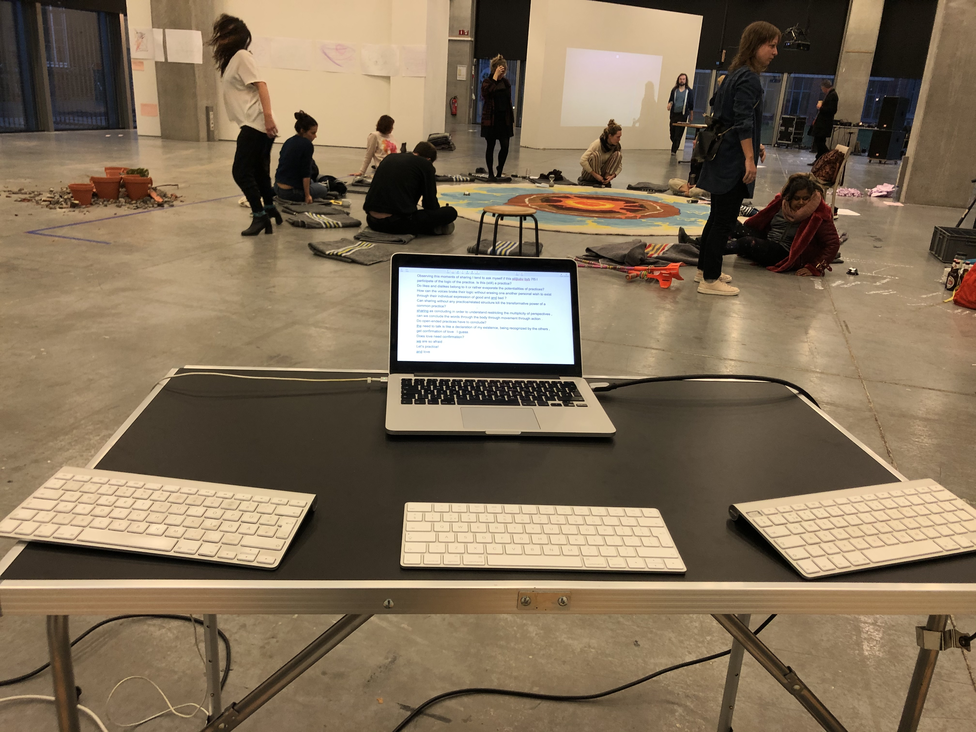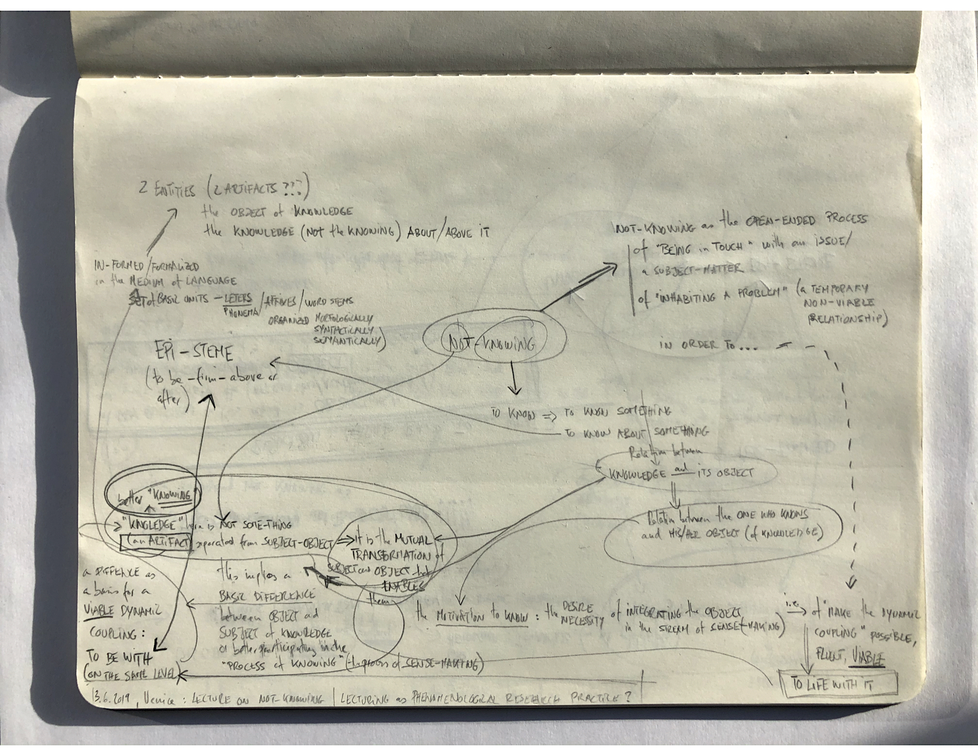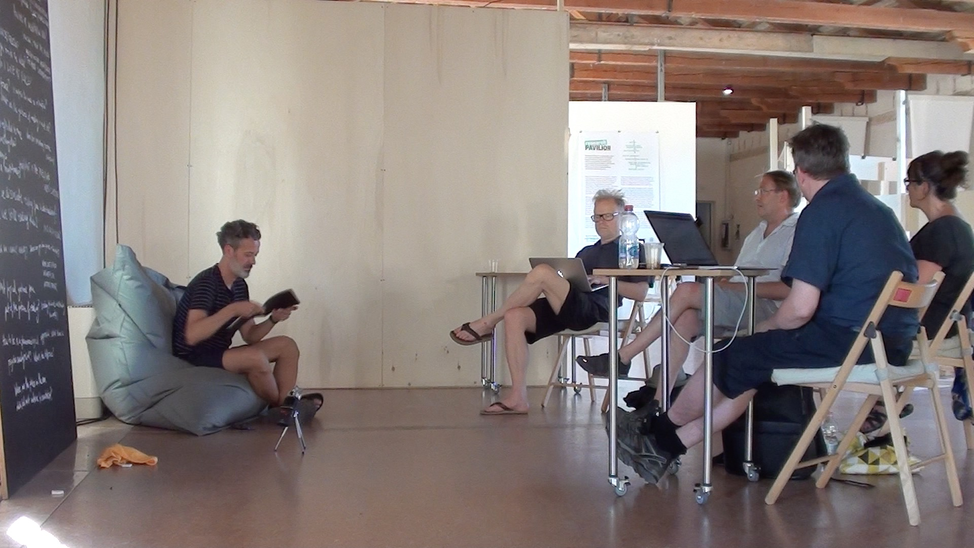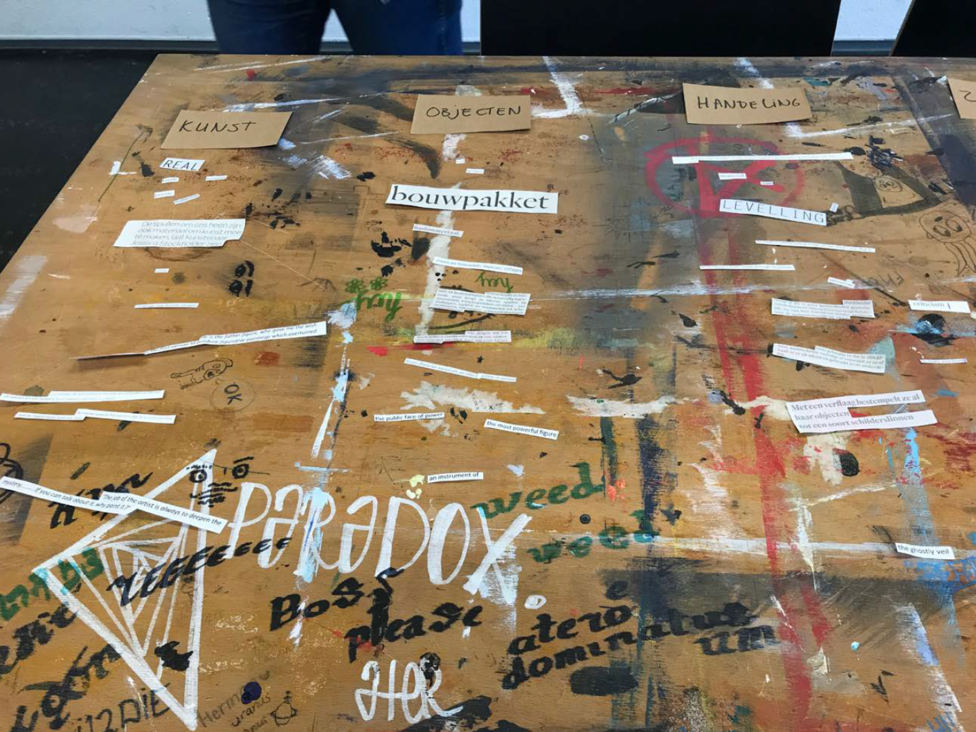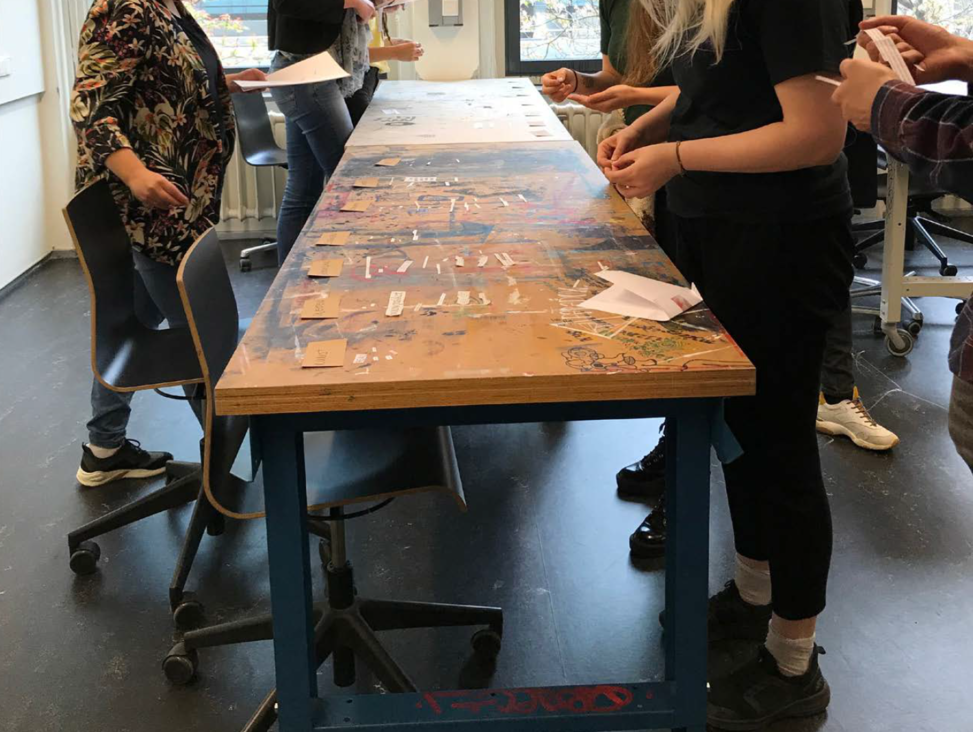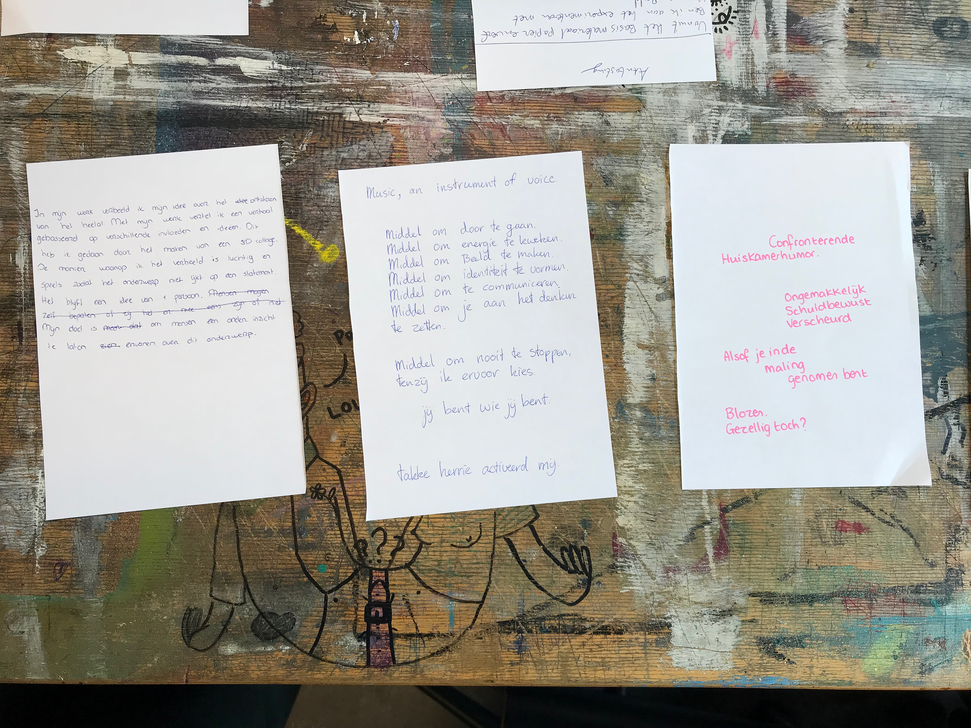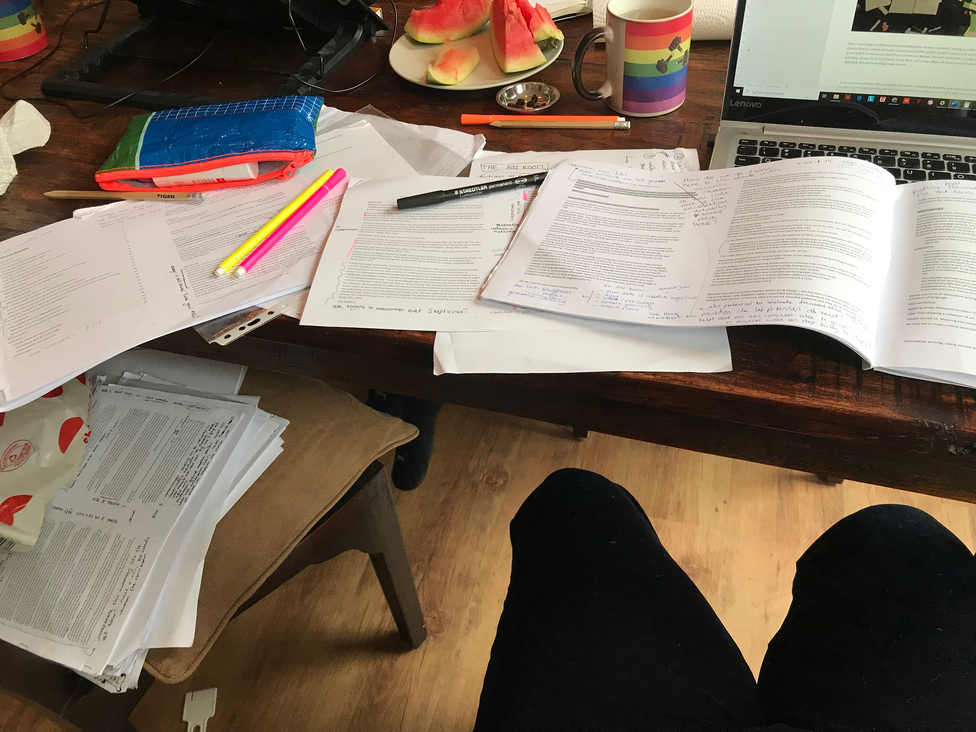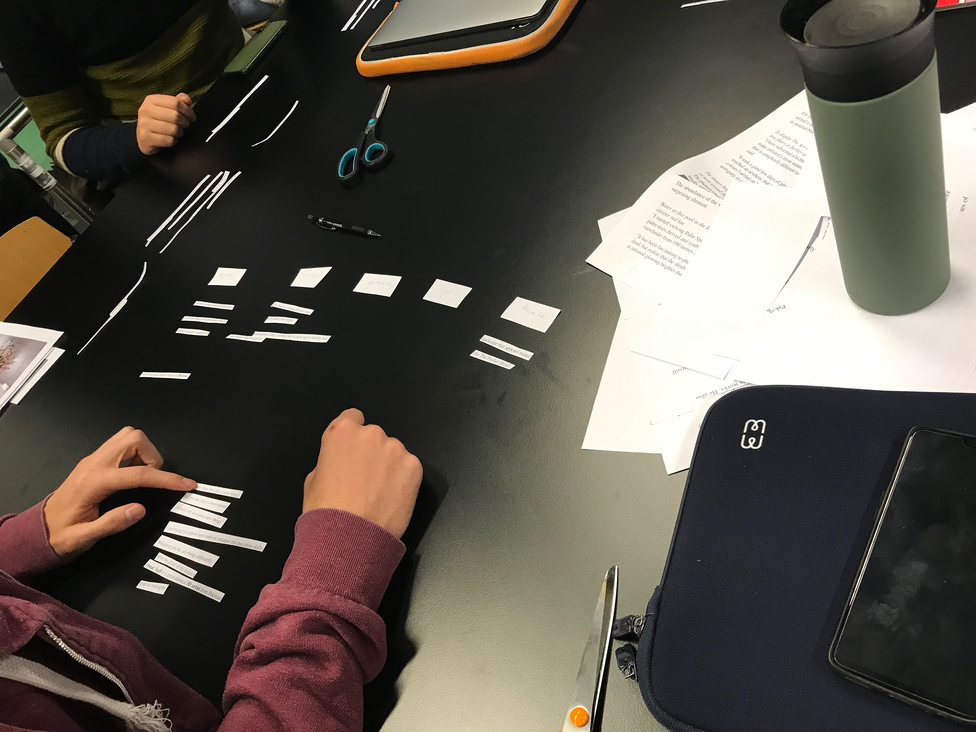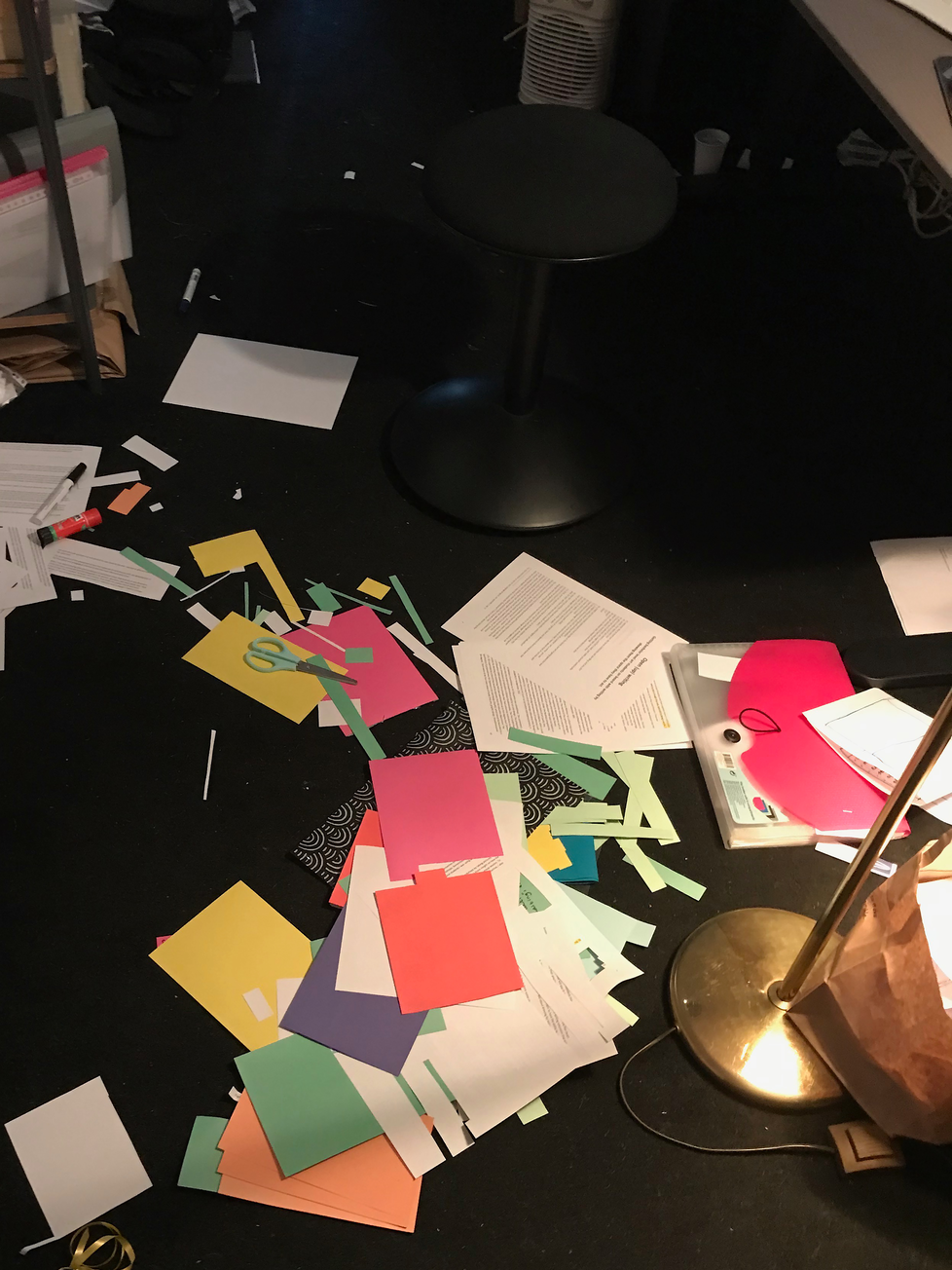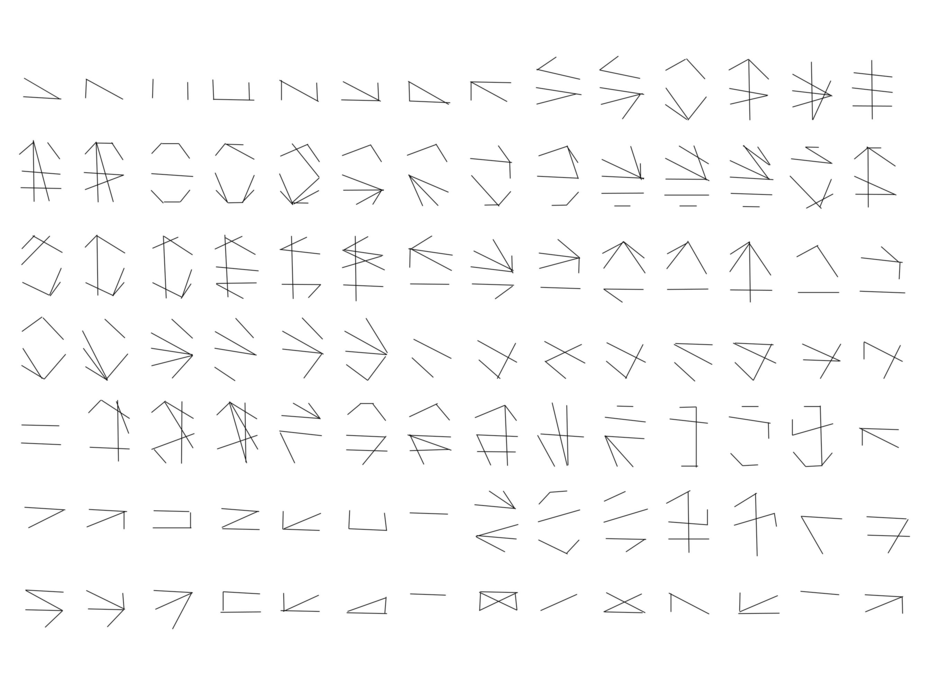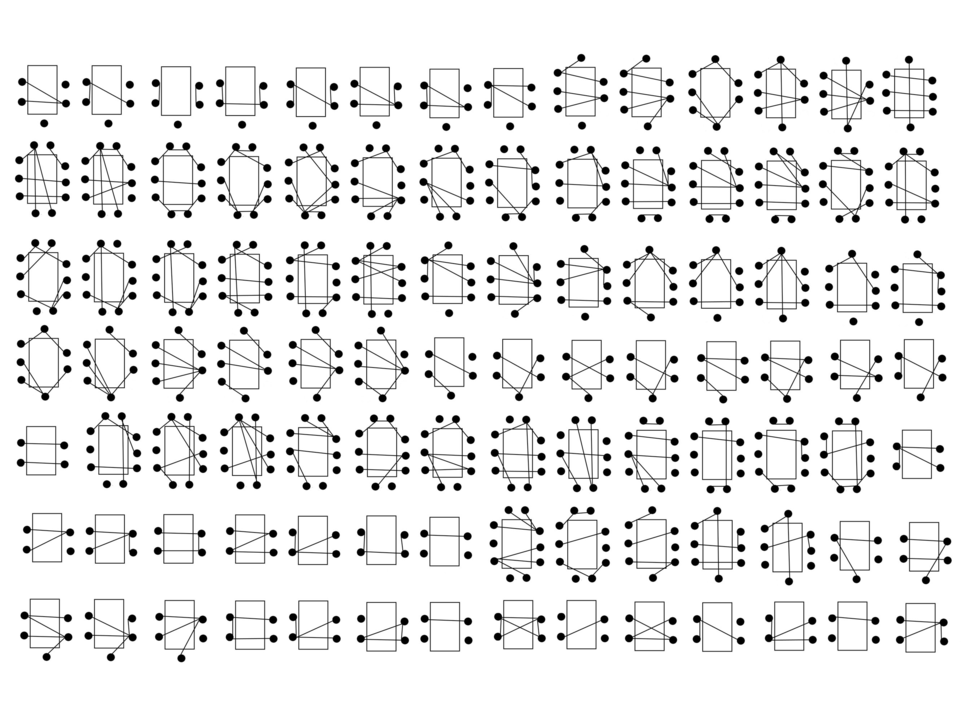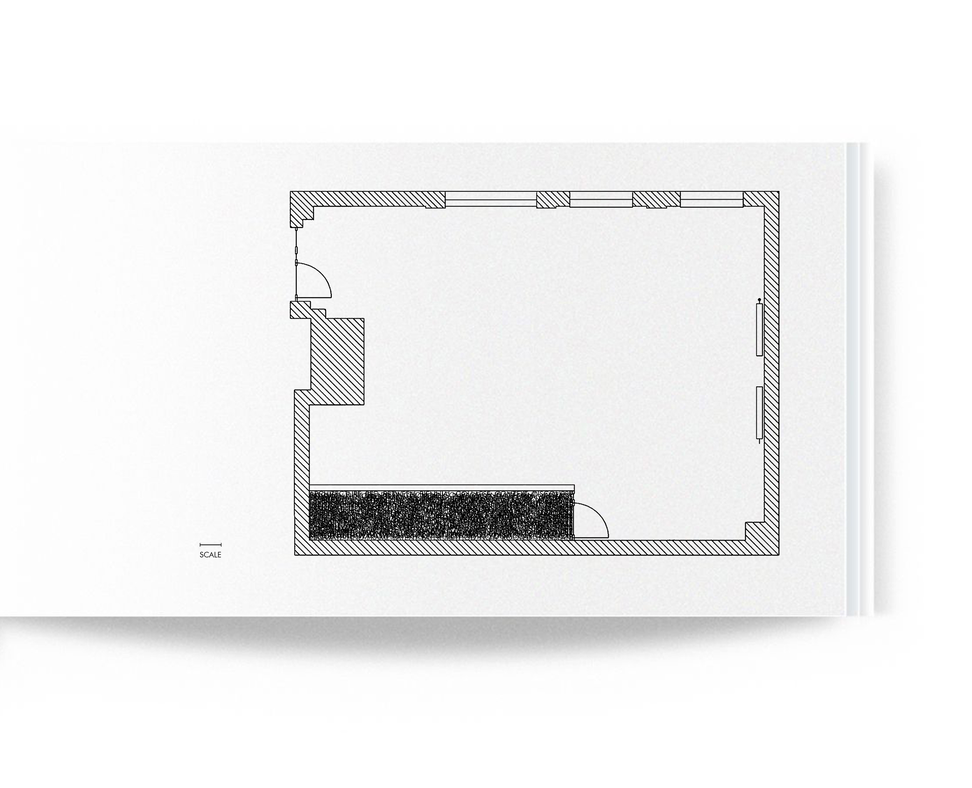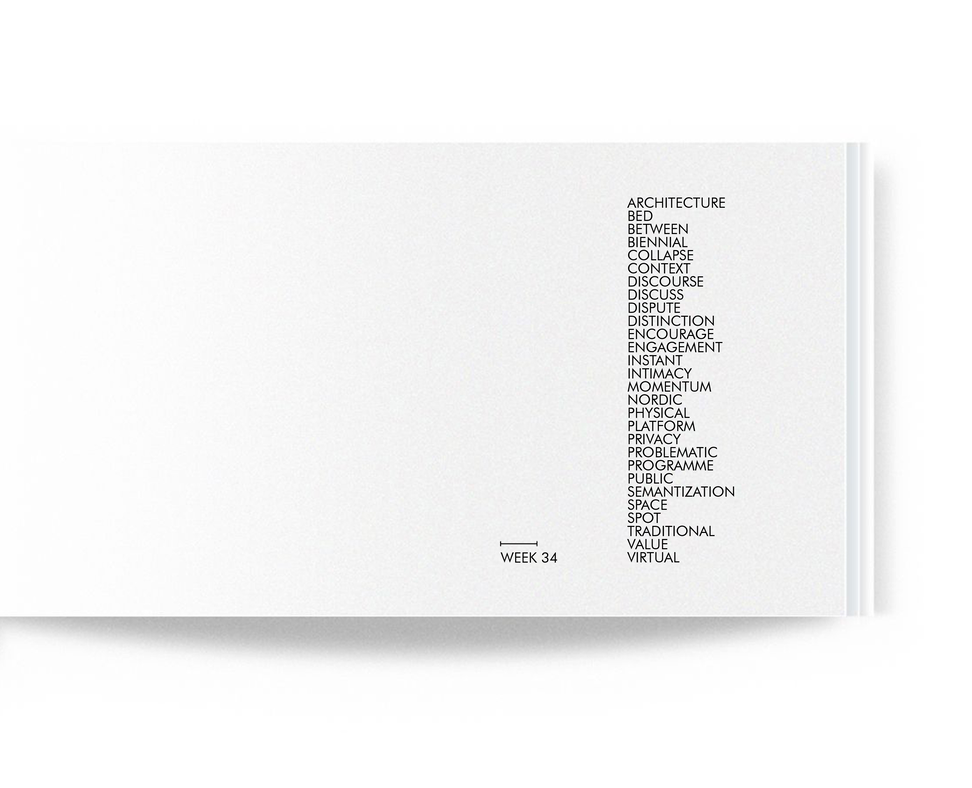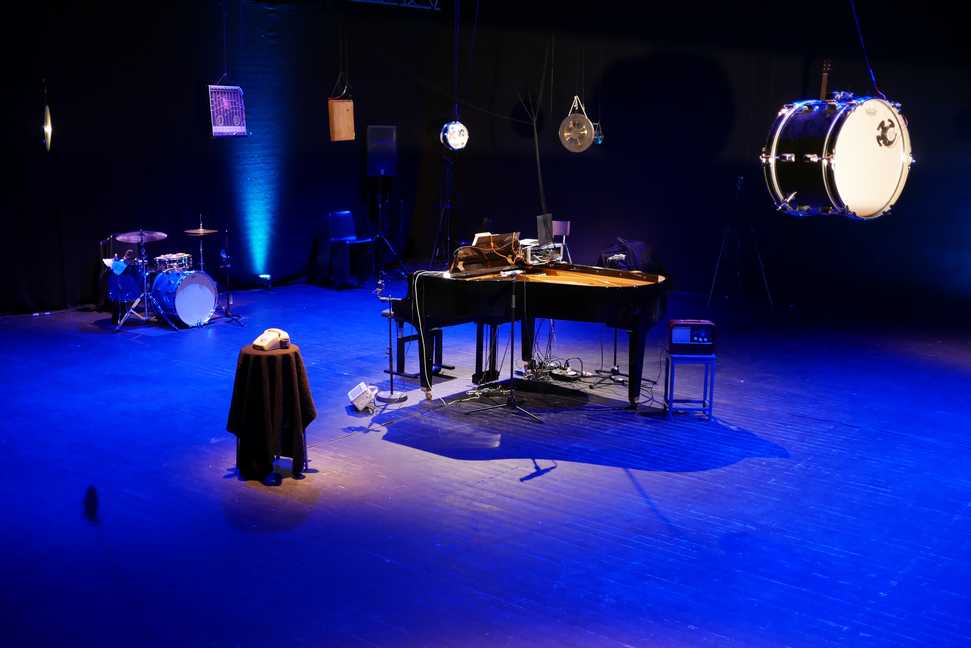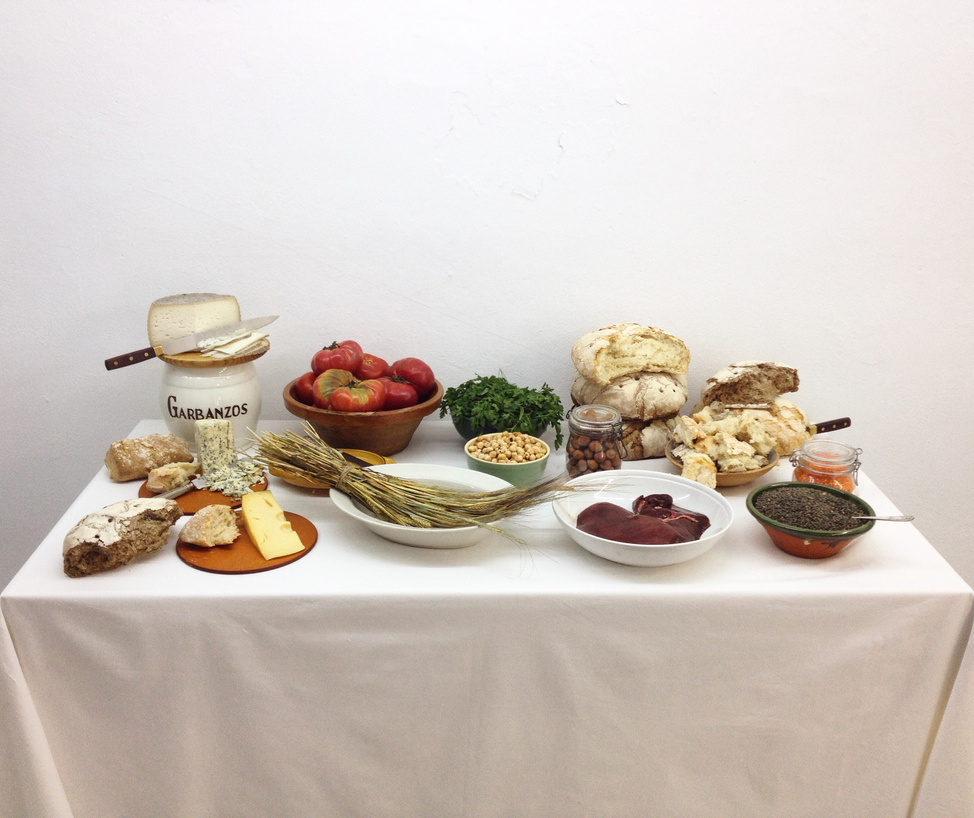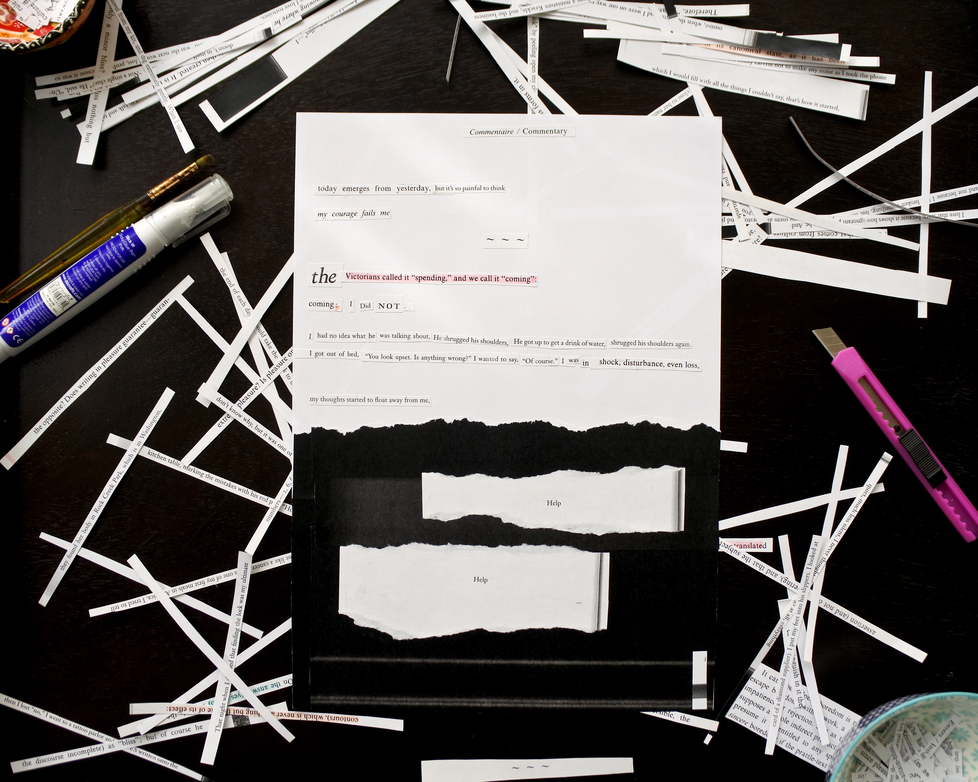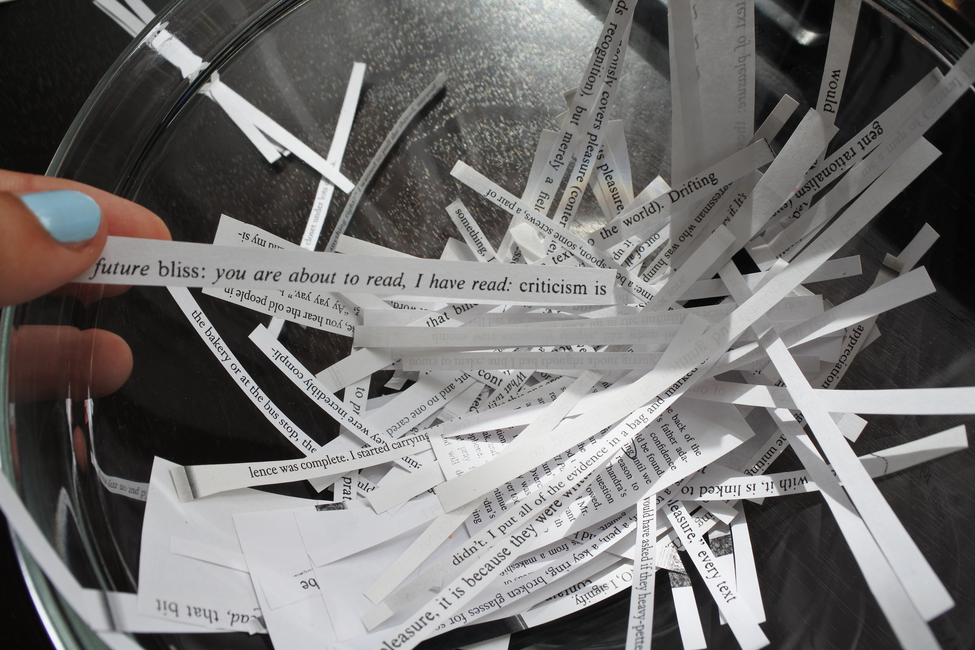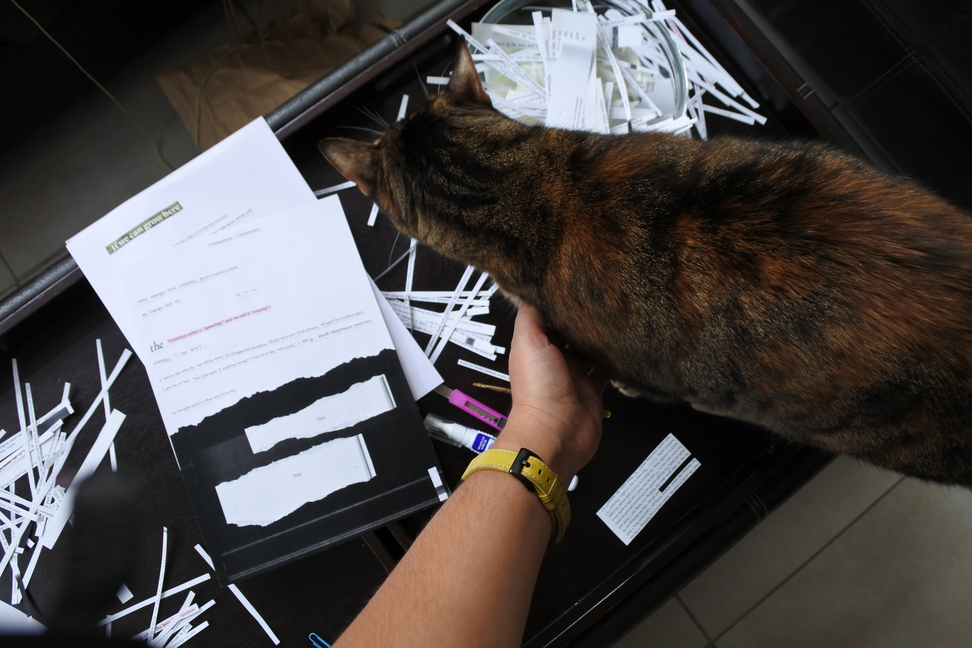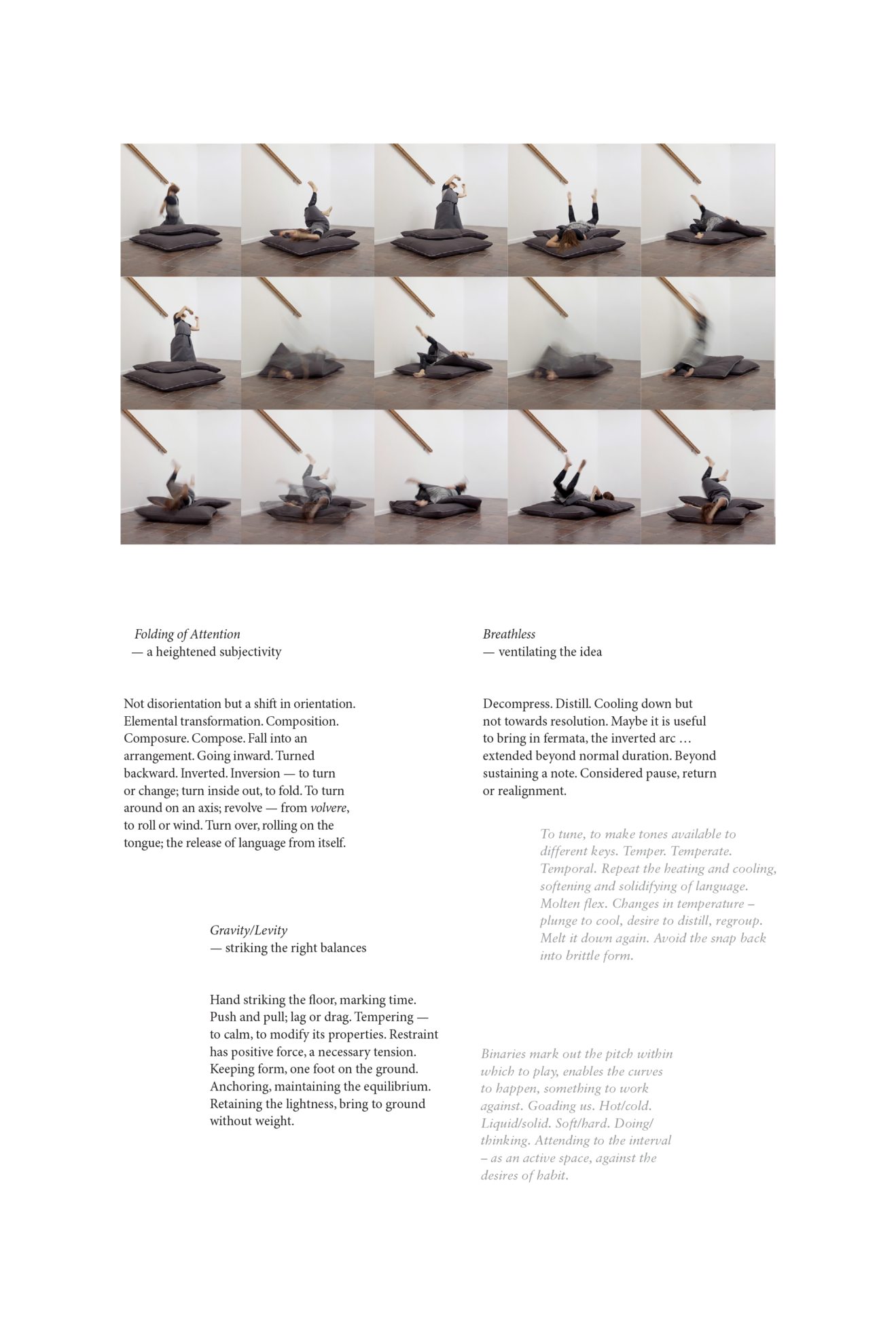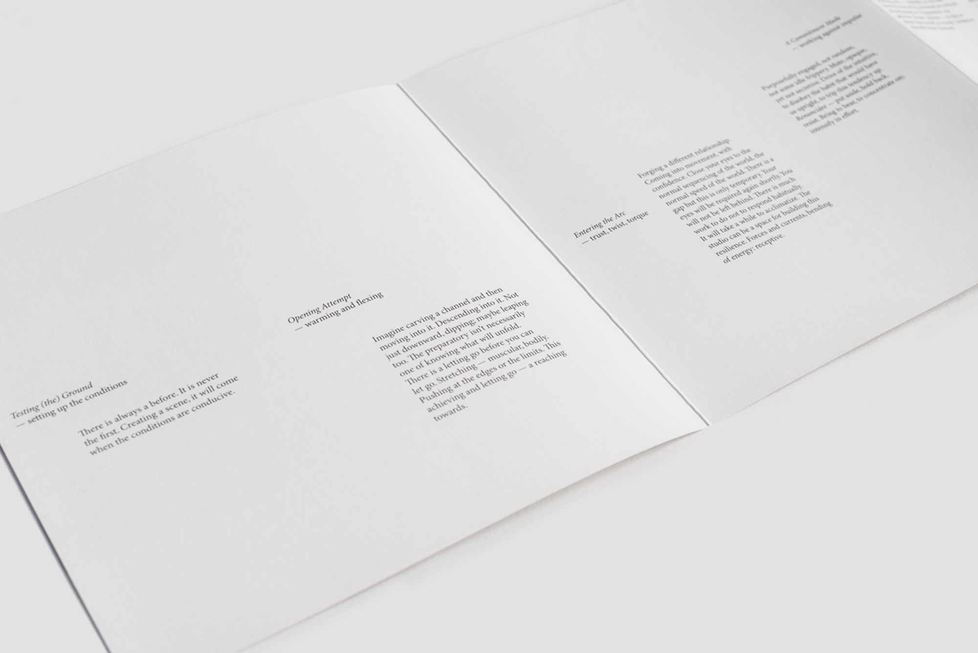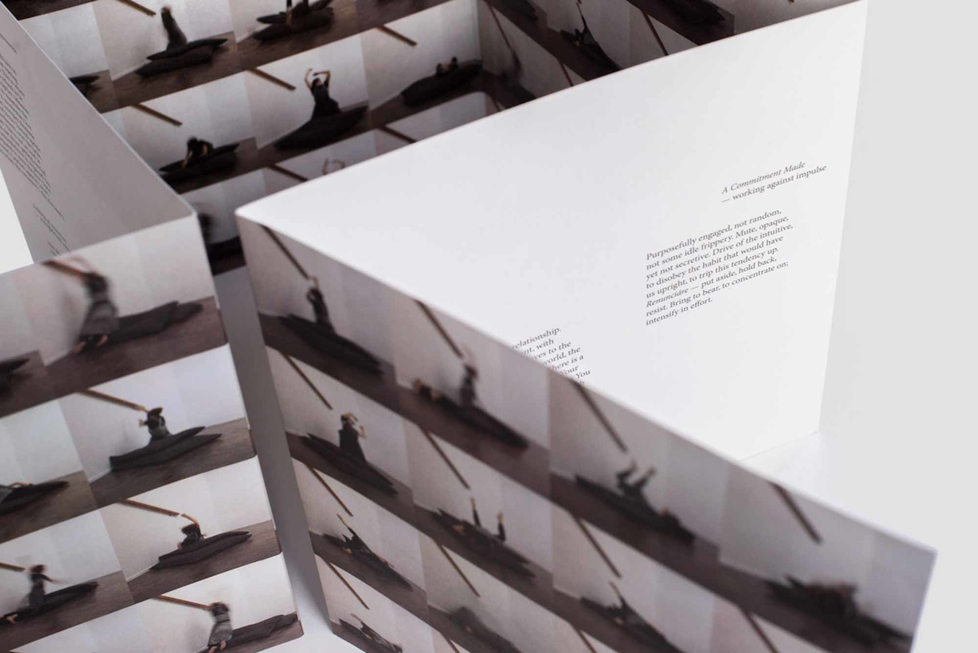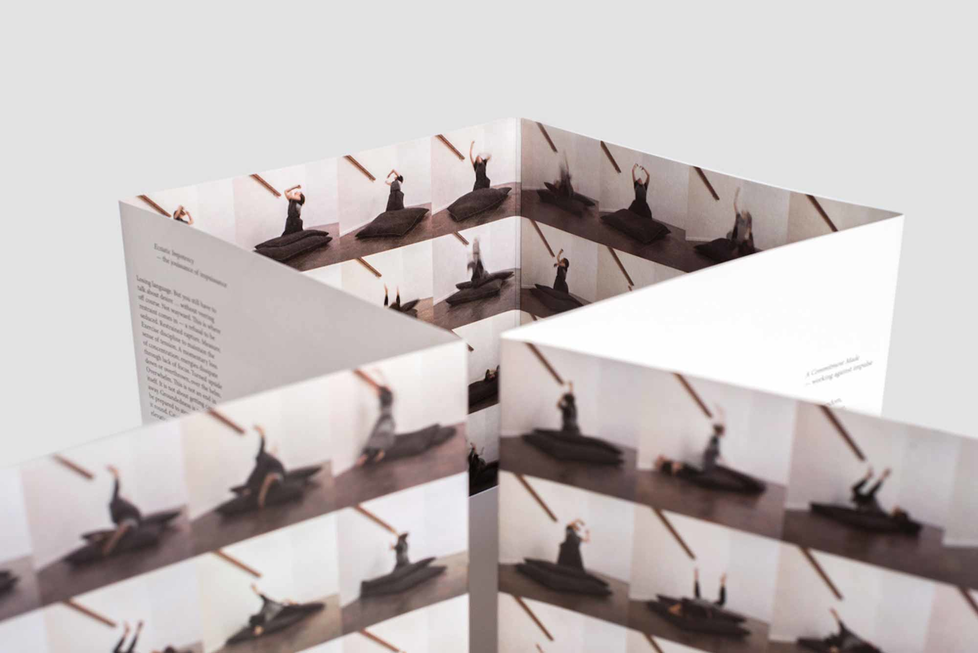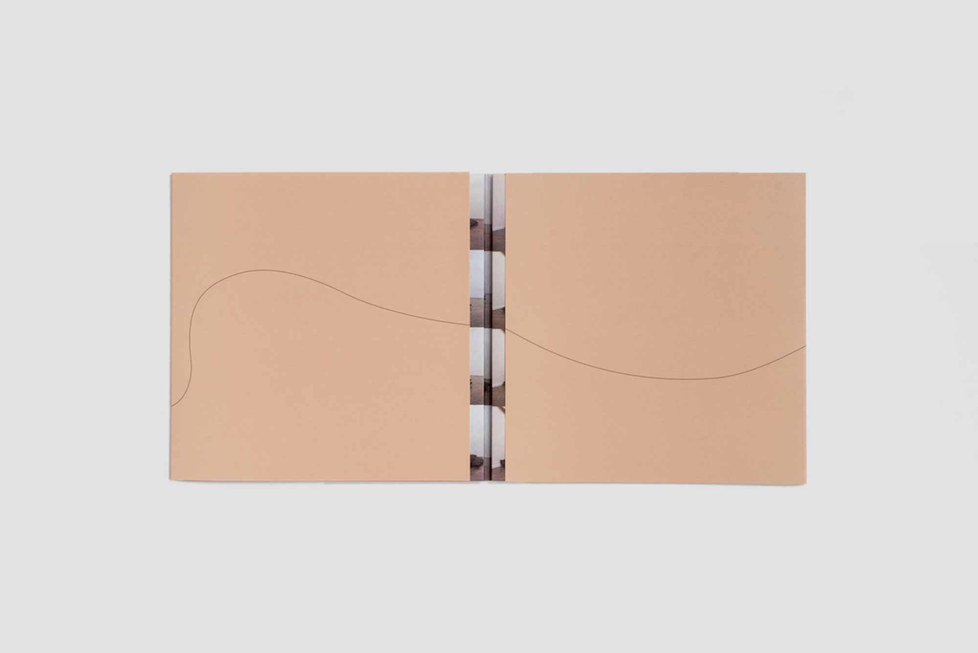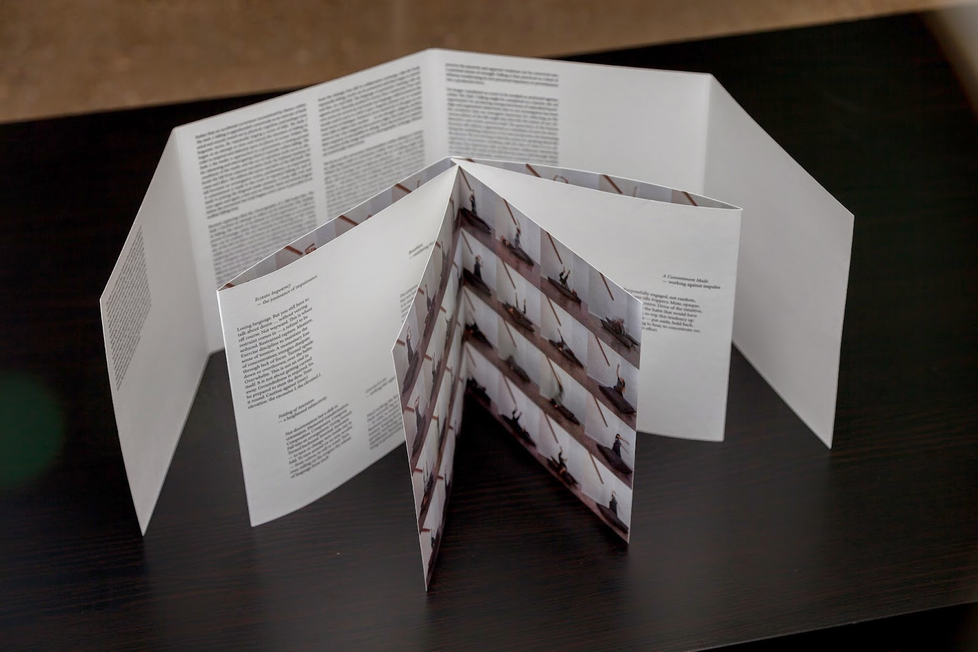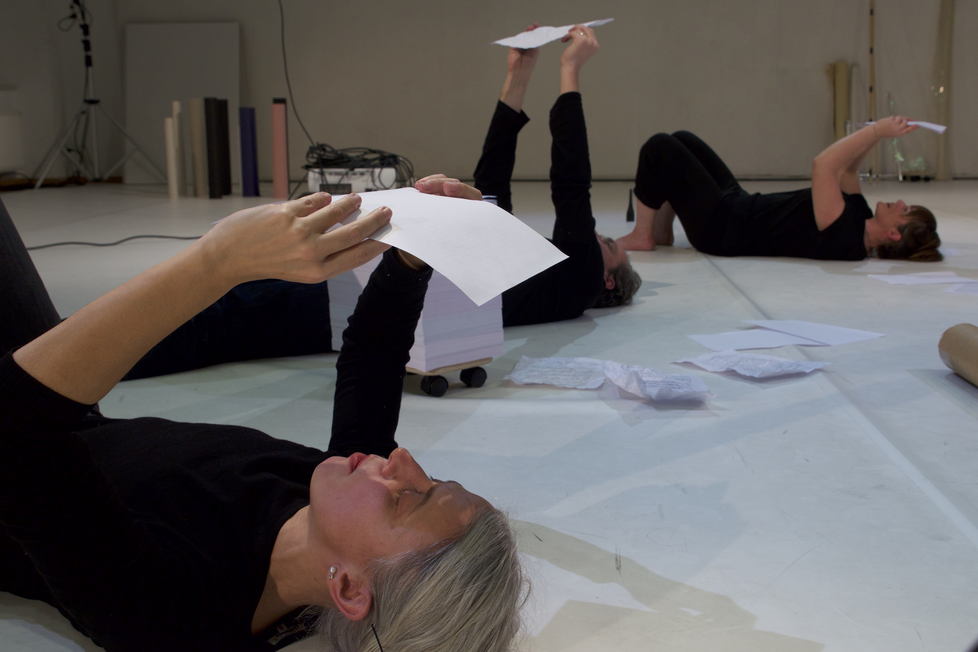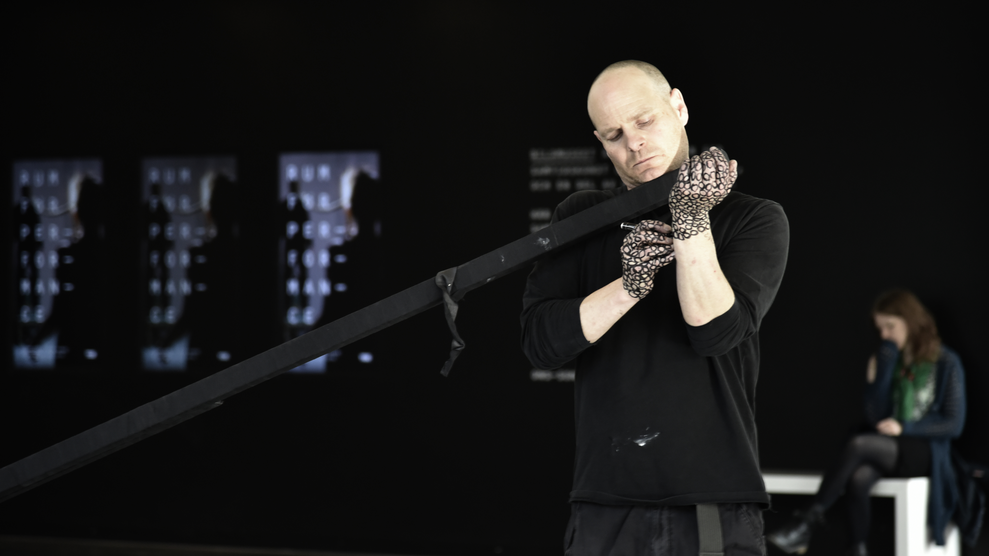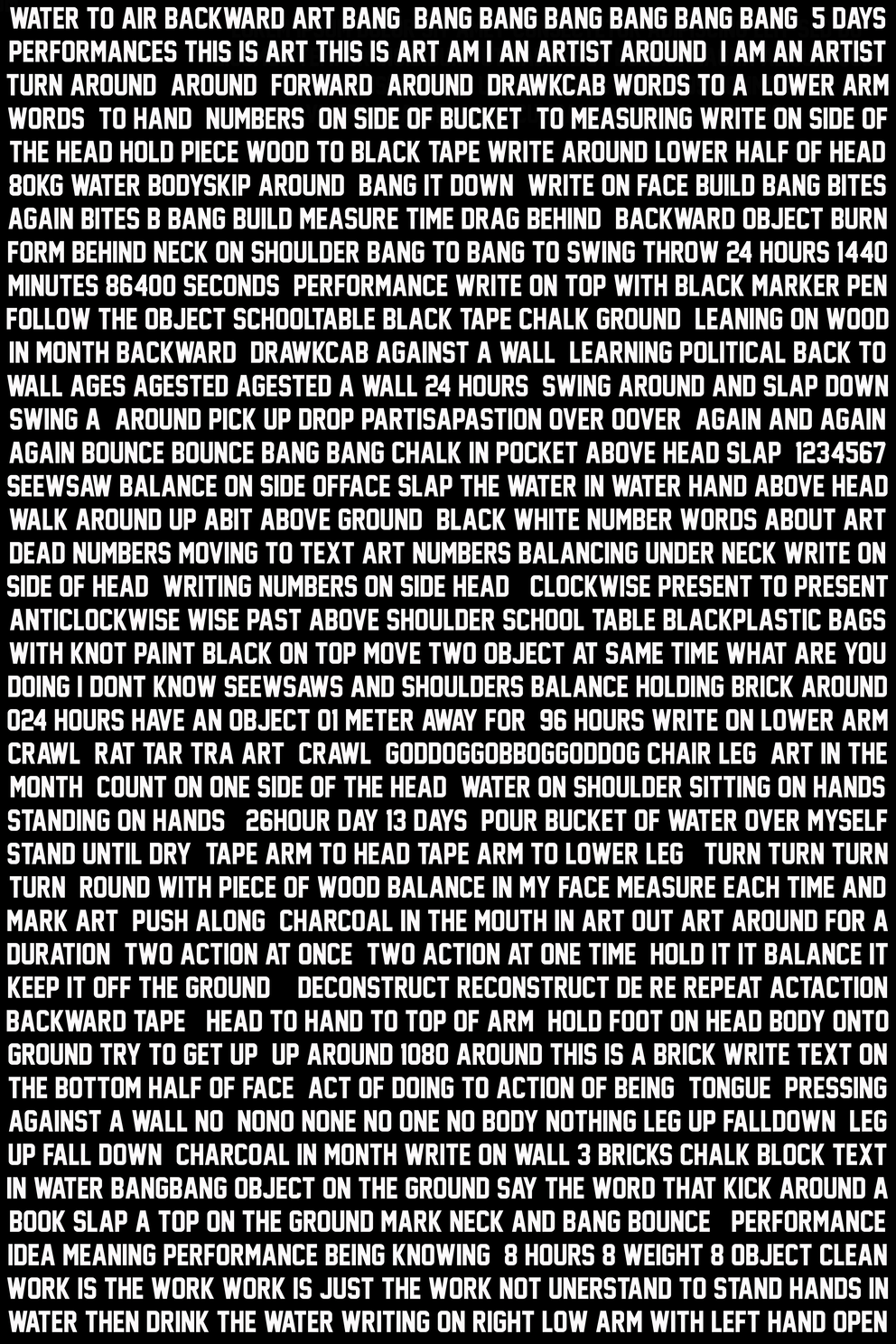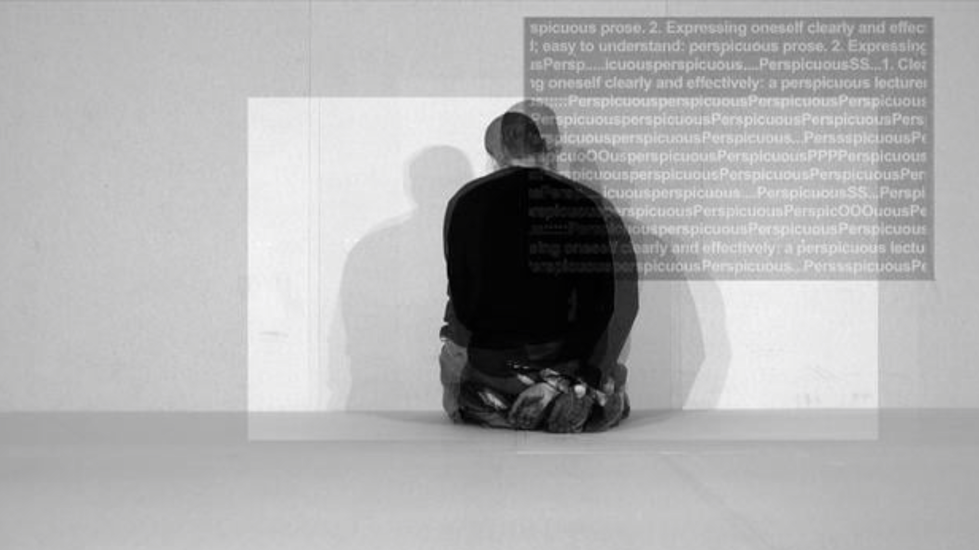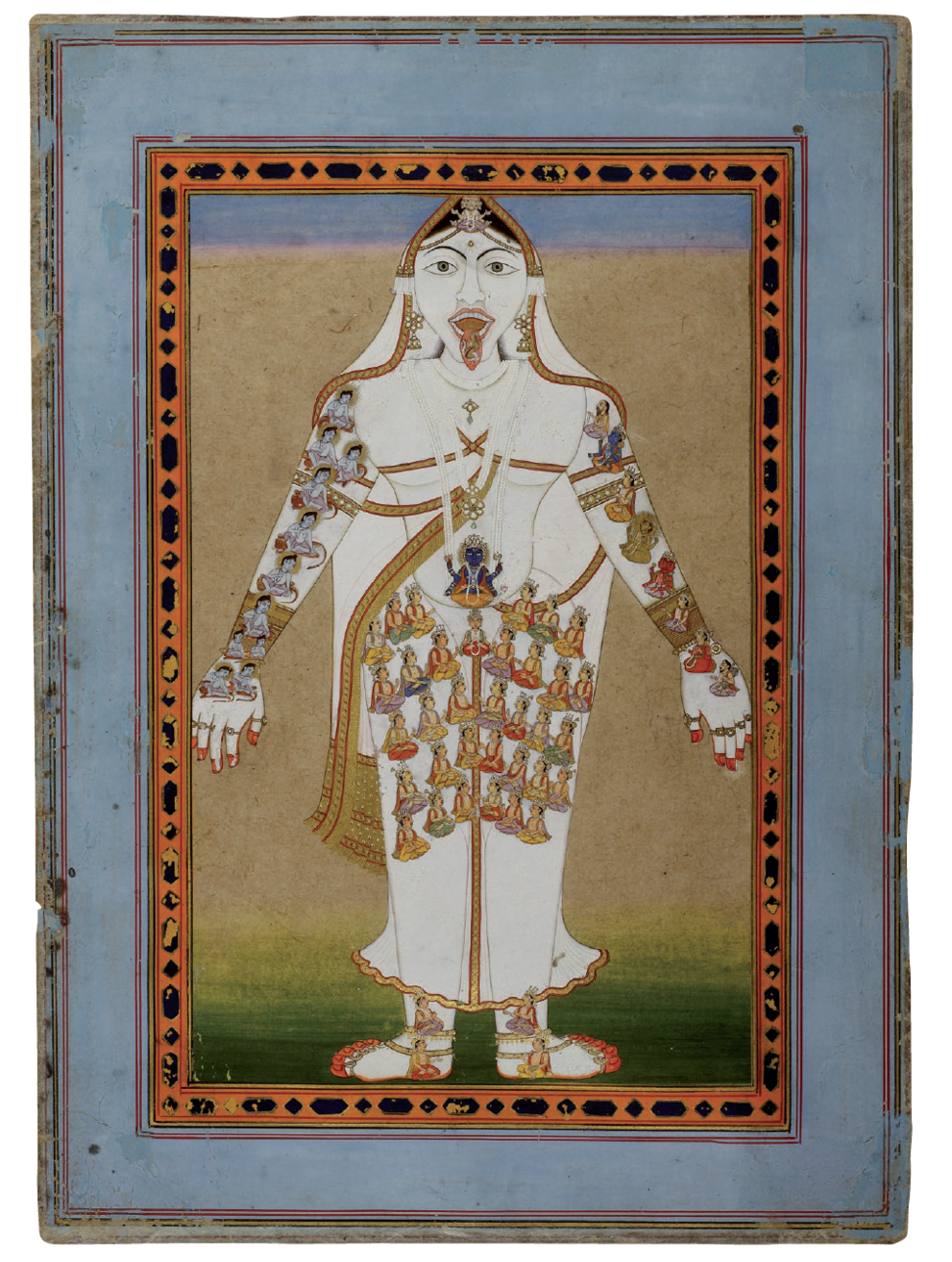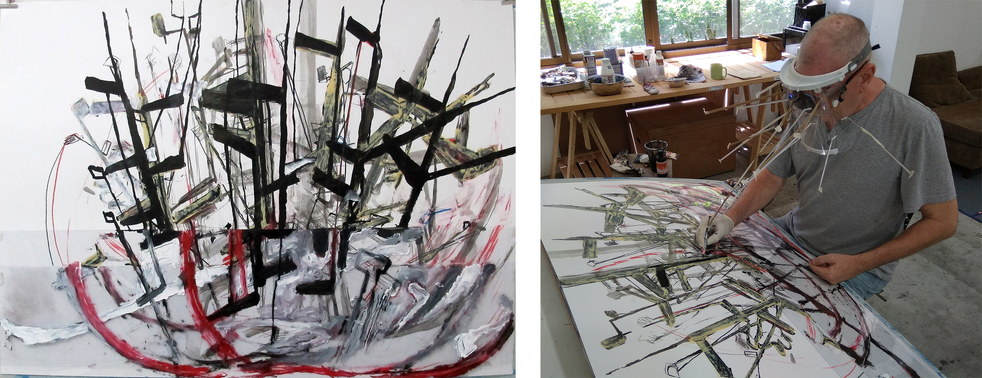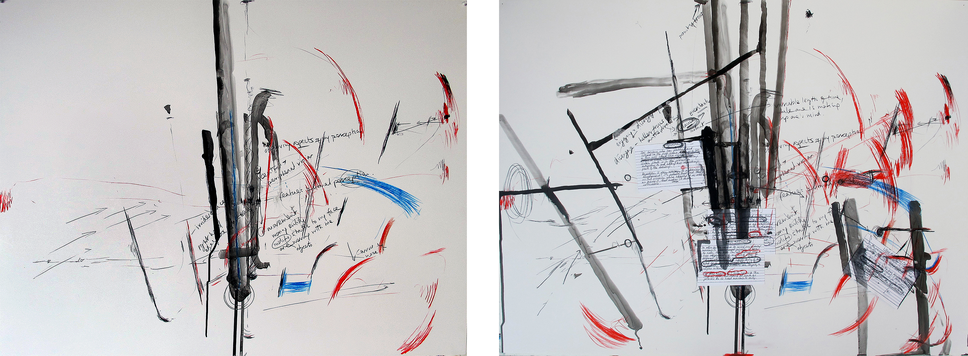Ana Carolina + Tatiana Melitello
scenic language
theater
listening
gesture
virtual space
poetics of attention
conversation-as-material
reading as an aesthetic practice
not-knowing
contiguous-writing
generative writing strategies
art writing
experiential writing education
writing as making
writing from image and text
The Japanese knotweed ( Fallopia japonica ) is one of the most hated plants in Europe and North America – yes it is. Many are the local and national campaigns and attempts to get rid of it. Municipalities and city councils perform different ways of controlling and eradicating the plant (varying from using chemical herbicides like glyphosate to mowing, soil covering, digging, and bizarrely enough, electrocuting); but to no avail. The plant regrows anew, and in some cases it comes back stronger. Like many other life forms, the plant has been used as a scapegoat for environmental problems mainly caused by climate change and (human activities) pollution. The media often depicts the Japanese knotweed as a horror plant • invasive • neophyte • exotic • ruderal • wild • daring • noxious • insidious • manoeuvrer • durable • popping up • menace • untamed • alien • contaminated • proactive • hazardous • infesting • stubborn • predominant • much-maligned • sturdy • risky • domesticated • non-native • blight • dioecious • dormant • arduous • extensive • monster • radical • sloper • bastard • asiatic • rampant • dominant • harmful • predator • unexpected • introduced • inconvenient • nuisance • encroacher • interferer • infamous • pernicious • monocultural • opportunist • outcompeting • fast-growing • affected • herbaceous • malicious • ornamental • perennial • superweed • profane • strange • non-economic • unwelcome • abundant • killer • infidel • unstoppable • fecund • door knocker • cruiser • carpetbagger • desperado • hermaphrodite • threat • vigorous • wrecker • aggressive • virulent • bioterrorist • hitchhiker • toxic • staggering • self-organized • primitive • freak • big • enemy • hardy • outsider • voracious • ruffian • alacritous • anti-nature • gypsy • bloody • newcomer • predatory • tough • rapid • competitor • colonist • exploiter • villain • turning up • thief • numerous • bizarre • disruptive • environmental harm • giant • incomer • prodigious • abnormal • nonlinear • other • scrapper • generalist • abrupt • pesky • carnage • first-movers • destroyer • unusual • disreputable • disease • imperfect • itinerant • pushy • weird • new arrival • weedy • irreversible • destructive • irritating • go-getter • immense • rogue • scary • thug • vagabond • unnatural • carnivorous • extreme • foreign • negative • mutant • burden • hungry • malign • invader • mischievous • suffocating • prolific • sick • migrant • mayhem • nasty • interloper • absurd • cancer • catastrophic • hybrid • pandemonium • versatile • in the doghouse • evil • felon • gang rape • pest • convulsive • diseased • distressing • troublemaker • triffid • psychotic • illegal • sensational • running riot • unwanted • bad • demon • hostile • resilient • scourge • ambivalent • bloated • new • guilty • hanky-panky • widespread • caprice • feral • poison • wicked • jostling • impure • curvaceous • hijacking • tenacious • merciless • vermin • uneconomic • manipulative • self-perpetuating • gargantuan • inevitable • conundrum • malodorous • oust • avaricious • vulgar • irrational • pseudo-wild • avalanche • locomotive • dangerous • outperforming • fast • pathogens • apocalyptic threat • havoc • predacious • reliant • impediment • problem • assassin • calamity • water thieves • novel • clog • indelible • victorian escapee • robust • immodest • cultivar • promiscuous • ravenous • overgrowing • persistent • notorious • impending harm • venomous • insurmountable • common • imported • expat • parasitic • southern • damned
THE DOG CHASED ITS TAIL TO BITE IT OFF traces the violent, xenophobic speech used to describe the plants and their parallels in the language often used to describe human migrants—a language that reveals the current human condition.
CREDITS
1. - 3. Installation detail (Weed Control group exhibition). Image of a book cover, segment of a Japanese knotweed stick, A4 sheet of research terms translated into Arabic, digital. Photo credit Romy Finke (Van Eyck Academy), 2020.
4. Installation detail (Weed Control group exhibition),video credit Essa Grayeb.
Alaa Abu Asad ±
My practice is centred around developing and experiencing alternative trajectories where values of (re)presentation, translation, viewing, reading, and understanding intersect. This is mainly done through looking at language which we use to communicate, share or exchange information, news and ideas; language which we receive, listen to, or hear; and other forms which were committed to oblivion—daily life dialects, particularly in the Arab world. Yet “new” ways of weaving the political value of the artwork in non-political affairs – if such things exist – constitute the core of questions about how to approach and (re)present a certain place and its language. How could a field-tour of observing flora be the pretext for addressing landscape, history, and colony planning? How does a process of collecting words from two different spoken languages / dialects comment on and contribute to a friendship and (oral) history at once? And why would studying the influence of invasive species be the trigger of accumulating consequences that provoke thinking about a society, its language, its media, and its behavioural economics? These multilayered concerns on the essence of the artwork, its production, its politics, and its language stimulate the ways of my seeing, together with other aesthetical matters of how to juxtapose static photographs with moving images (video), and (written/outspoken) texts / words. How can these concerns comprehensively convey personal and common experience/s of the individual and the collective, without ignoring actual events and (past) histories that shape memory?
I LOVE IT WHEN TRANSLATION CAN BE FOUND TO AGREE WITH OUR WEIRD DESIRES
With Ulufer Çelik, 2017-2020
Do you know what şemsiye means? Do you use the word kırbaç for a whip? For around three years, we have been asking each other about identical words used in both of our languages: Turkish and (vernacular) Palestinian Arabic. A process that can last for good – as long as our friendship lives. We spend time together uttering words that are in common and draw them, whether they carry the same meaning, were slightly different, or were false friends.
No matter how close or different the words were in their meanings, the way they are articulated is always peculiar to the out speaking of the person and her dialect/language. The selected words carry an oral history which is often ignored by academic / linguistic concerns, as many of the research resources focus on Classical Arabic only ( العربیّة الفُصحى , al-ʿarabiyyah al-fuṣḥā), which is the Quranic Arabic, or the standardized literary form of the Arabic language used from the 7th century and throughout the Middle Ages. And in doing so, they reduce the numerous spoken dialects and forms of vernacular languages into one FORMAL type of the language, which is scarcely used in everyday life by the general population of any Arab country / community.
‘I LOVE IT WHEN TRANSLATION CAN BE FOUND TO AGREE WITH OUR WEIRD DESIRES’ motivated us to insist on the daily spoken words as an innovative take on translation, pluralistic language, and semiotic history.
CREDITS AND LINKS
1. Video Extract
2. Book cover, 2019. Photo credit: Matt Hinkly
3. Book detail (left) identity, (right) Hebrew, 2019. Photo credit: Matt Hinkly
LINK TO FULL VIDEO
“Exploratory essay writing” is a practice that enables a very slow aesthetic observation of a concept. The starting point is a state of not-knowing the concept to be addressed. Being aware that the concept at stake has already a meaning for me, I position myself towards this concept as if I would encounter it for the first time. This encounter is enabled by specific technologies of writing (usually my laptop) and my bodily actions, both embedded in a situation typically conditioned by a certain furniture and architectural constructions. To write very slowly allows me to become operatively aware of the actualization of the agencies of all these entities (technologies, my body, my surroundings) and of the agencies of the emerging text. Consequently, the process of writing develops in and by virtue of a field of shared agencies. This requires to regulate in a very specific way the performance of my intentionality. While writing I pursue neither cognitive nor formal goals. Instead, I reduce the exercise of my intentionality to the maintenance of my interactions on a sensorimotor and emotional base and thus to be extremely receptive to the process of writing and the ways in which the observed concept reacts, that is, the possible transformations of its phenomenal presence. Currently I am extending this practice in different ways: reading my essays publicly and trying different forms of collective writing both in architectural (semi)public spaces and in online frameworks.
CREDITS AND LINKS
1. “Essaying on practice”, in the framework of the symposium “…Through Practices” (KASK, Ghent, October 28 to 30 2019). Copyright: Alex Arteaga
2. “Essaying on practice”, in the framework of the symposium “…Through Practices” (KASK, Ghent, October 28-30 2019). Copyright: Alex Arteaga
3. Alex Arteaga’s reading of fragments of his exploratory essay “Disclosing an architectural object”. (festival Performatik. KANAL, Centre George Pompidou, Brussels, March 22 2019). Excerpt of a life-recording. Copyright: Alex Arteaga
LINK TO TEXT - Disclosing an Architectural Object
Alex Arteaga ±
I consider the language-based research practices that I conceive and perform to be aesthetic practices of very slow observation. The term “aesthetic” designates here a variety of interaction between researcher and object of research characterized by an intensified use of sensorimotor and emotional skills and a minimization of will-based and target-oriented forms of action. On this basis, the formulation “very slow observation” stands for an extensive perceptual exposition of the researcher and the inquired issue to one another.
I regard my practices as aesthetic phenomenological practices. This means basically, that I address the objects I research as phenomena. I inquiry into issues through their phenomenal appearance—though the way they manifest themselves to me. I observe phenomena: dynamic, fragile presences co-constituted by the agencies of the inquired thing or state of affairs, of my subjectivity and of the environment in which the observation occurs. In doing so, my aim is not to generate knowledge about the inquired issues, but rather to destabilize them—to disrupt their phenomenal steadiness—in order to disclose new possibilities of intelligibility, that is, to enable new processes of constitution that possibly lead to different phenomenal expressions.
Through my language-based practices I aim at fulfilling this function by mobilizing the agencies of the medium language: the morphology of written and spoken signs, the ways in which they relate to one another on a surface or in time, their syntactic articulation, their semantics and the technologies of writing, reading and speaking.
“Framed dialoguing” is a collective language-based practice that mobilizes and connects the cognitive agencies of diagramming, reading and conversing. In a preparatory phase, I address the issue to be investigated by realizing a conceptual diagram. I enter in touch with the object of inquiry by using a particular technology of writing (usually a pencil and a note book) that allows for the emergence of ideas and for relating them to one another through their specific distribution on a surface and the use of graphic elements (lines, arrows, different forms of marking and highlighting). I—we: all the agents involved (the technologies of writing, my body, the different elements of my surroundings, the emerging signs)—continue diagramming until a certain conceptual coherence able to induce and frame a dialogue crystallizes.
The explicitly collective practice begins by explaining the process I already underwent and the process to which I invite other practitioners to participate. I show them briefly the diagram and explain that I will begin to read it in order to reenact and share the notated ideas and their relationships. I ask them to intervene as soon as they want to comment or question. Once we enter in a conversational flow, I might use the diagram in order to reframe the process and maintain the contact with the observed issue. I do not aim at reading the whole diagram. We come to and end when we collectively feel that the process has lost its cognitive agency.
CREDITS AND LINKS
1. Diagram for the framed dialogue on “not-knowing” in the framework of “lecturing as phenomenological research practice” as part of the research cell “Through Phenomena Themselves” (Research Pavilion #3, Venice, June 13 2019). Copyright: Alex Arteaga
2. Framed dialogue on “not-knowing” in the framework of “lecturing as phenomenological research practice” as part of the research cell “Through Phenomena Themselves” (Research Pavilion #3, Venice, June 13 2019). With Esa Kirkkopelto, Mika Elo, Emma Cocker and Juha Himanka. Copyright: Alex Arteaga.
LINK TO EXPOSITION
Creating artist statements by switching between generating and reflecting
This three hour workshop consists of three parts: writing from text, writing from image, and bringing the two together.
(1) The students are asked to bring in a text that inspires them. From these texts, they cut out words and sentences that appeal to them. They divide these cut-outs into categories such as ‘object’, ‘space’, ‘thoughts’, etc. on the same table. The students read some of the selected texts out loud to get a feel for the quality (tone, rhythm, feel) of the language. They then select whatever text resonates with them, and that they feel says something about their art, and use this to create a visual poem on A5 paper. After looking at the results, they reflect on them in groups of three. They are provided with a list of questions like: ‘Why did these words/sentences appeal to you?’ and ‘What do you hope an outsider would pick up on when seeing this text?’ One student asks questions, one responds, and the third writes down the answers. After everyone’s work is discussed, the students write down their insights.
(2) After a short explanation of art writing, the students read a fragment of the book The legend of the necessary dreamer by Maria Fusco. They discuss how you can use a sensory experience (using sensory words and/or zooming in on sensory elements of a work) when writing. They all do a free-writing exercise on the same image and share the results. After this they do the same thing, but on their own work. The students read texts by Dylan Thomas and Ernst Jantl, and discuss the various ways language can be used for a text. The students write about their own work again, after which they reflect on the two texts (individually, in writing), by answering questions like: ‘What do you notice about the texts you wrote?’, ‘How would you describe the mood of your texts?’, and ‘How would you like an outsider to interpret your texts?’
(3) The students go through all the material they have generated, including the reflective texts, and cut out (or highlight) everything that appeals to them. They place their selection in front of them and, using this, write their artist statement.
CREDITS
1.–2. Lesson with associative degree arts and crafts students.
3. Texts written by Fine Art and Design teacher students.
Marjolijn van den Berg ±
As a writer, I believe that language can be a powerful tool. But you have to know how to wield its power. A lack of insight into the writing process and not knowing how to overcome obstacles can make you feel like writing is inherently difficult and ‘just not for you’. But I think writing is a good addition to anyone’s toolbox, including those students we just looked at. So, I asked myself the following question: ‘How can pedagogical and didactic approaches informed by artistic and creative writing strategies contribute to making Art and Design students more comfortable with writing?’
In my research, I explore what being comfortable (and uncomfortable) with writing means to me and others, and how it is apparent in my students. I look at the work of artists and writers, like Kenneth Goldsmith and Maria Fusco, and investigate concepts like generative writing and experiential education, in search of (creative) writing strategies that will help students grow as writers. I have used my findings to construct writing workshops, which I have tested with multiple groups of students.
Besides looking for answers, I also try to illustrate the potential of language by not just using the voice of teacher and researcher. In my research, I make my voice as a writer heard as well.
I am a core-member of the research group Beyond Freewriting: Writing and Research of the Professorshop Performative Processes at HKU Utrecht University of the Arts. The research group explores the ways in which both artistic research and artistic practice can be disseminated in writing.
Teaching writing by focussing on the process as a whole
Look over there. Do you see that group of students down the hall? They are just standing there, looking at their feet, sighing. They are waiting for a class where they need to write a self-reflection document.
The students nudge each other when their teacher walks by,
rolling their eyes.
‘I can’t believe we have to do this.’
‘I know man.’
‘Writing is not just “challenging,” it’s oppositional to making art,’
replies another.
They nod their heads in agreement. When the teacher says it’s time to start the class, they shuffle in.
I believe that a big part of students’ resistance to writing stems from how students learn to write. One of the things I’ve noticed when it comes to teaching writing, especially non-fiction, is that often the focus is on what the end-result should be, not on how students might get there.
In her book Inspiring Writing In Art And Design Education: Taking A Line For A Write Pat Francis talks about the difference between how Art and Design students are expected to think about their process in their practice, and how they’re expected to think about it in their writing. In their practice they are encouraged to find their own way, but when it comes to writing this idea of ‘celebrating differences’ is strangely absent. Francis states: ‘They are either not introduced to possible ways of working, or are encouraged to think that the final logical structure of a written piece, read left to right, front to back, reflects the way it is evolved.’ (Francis, 2009, 29)
For me, writing is about creating, about exploring, about trying to capture thoughts and feelings in words. And this is a messy business. My workroom, when I am in the middle of a writing process, has been described as ‘that of a nutty professor’, and ‘the aftermath of a hurricane passing through.’ I need the work to be tangible. For me, writing is a physical act. I walk around the room, I read texts out loud, cut them up. I have different versions of texts lying around and my walls are filled with mind maps. Reflections are scribbled in the margins. But when you see the final version of a text, you may never expect the chaotic process that led to the polished end result.
The way Francis talks about how Art and Design students are encouraged to find their own process in their practical work made me realize: maybe students are able to use this experience to their advantage in writing? Because they are used to the messiness of a creative process, they may be more likely to understand, maybe even embrace, ‘the unorderly, but dynamic process’ of writing, as long as they can recognize it as such. (Flower and Hayes, 1977, 461) This realization led me to explore the concept of teaching writing as making.
Francis, P. (2009) Inspiring Writing In Art And Design Education: Taking A Line For A Write, Bristol: Intellect Books
Flower H, Hayes J. (1977) Problem-Solving Strategies and the Writing Process. College English 39 (4) p. 449-461
CREDITS
1.-3. Lesson with associative degree arts and crafts students.
For a period of one month, I documented all the conversations between my flatmates, taking place around the dinner table in our home. The act of sharing a house involves specific dynamics that extend into its spatial composition, consisting of a range of personal and collective areas. In this case, the dinner table assumed an important role as a communal space, generating social interaction at an intimate level. (See Image 1)
By observing conversational exchanges between people, not focusing on sender, receiver or content, maps of dialogue trajectories were assembled into a sequence of diagrams. Gradually, interplays further from memory to become a form of data. In some ways, the reality of being around the table and this methodology merge in the imaginarium, culminating in a manufactured and laborious existence. (See Image 2)
The resultant patterns prevail as remainings of an ephemeral interaction placed around collective encounters, significantly reflective of the environment and frequency of co-habitation. This proposal marked the beginning of a research which would extend itself in time and into other contexts. In 2017, it was published in the Novelty Magazine along with a small essay.
CREDITS
1. Extract from Dialogical Patterns Proposal I
2. Extract from Dialogical Patterns Proposal I
Ana Brotas ±
My practice is concerned with researching meeting points between knowledge production, linguistic systems and modes of storytelling. Alongside a pedagogical interest in alternative forms of learning, past projects have been situated on collaborative and interdisciplinary grounds. Either as cycles of sharing, collective processes or responding to specific sites, I often embrace an analytical but simultaneously playful approach, through orality and technology. Currently, I am undertaking the Master in Art and Public Space at the Oslo National Academy of the Arts. My recent investigations have consistently considered communication as a public sphere. Furthermore, language has been unveiling a seductive craft which constantly weaves coincidences between reality and fiction. It not only refers to, but also composes the contexts we inhabit. Particularly examining orality and technology as infrastructures for communication is, in many ways, interrelated with notions of public outreach. By questioning strategies, problematics and implications in linguistic devices, I attempt to investigate dialogical interactions and their possible modes of tracing. This framework has been materialized in a series of proposals that aim to test various degrees of involvement within the circles which I consider myself a part of.
For a period of four months, I collected the words that were most used in conversations with my colleagues in the shared studio space of the Master Programme. Resulting in 16 collections, one per week, various analysis methods were used in order to identify specific discursive propensities. (See Image 1)
Researching the linguistic modes of critical expressions, legitimated within this concrete context, reinforced the intention to refer back to the physicality of the environment. Using the studio’s architectural plan, an additional storage room was constructed, which proposes to archive the collections. The message was consequently compressed to become a form of noise. This new fictional place, assembled from a simultaneously personal and shared experience, encapsulates the affective and critical practices that have occurred thereon. (See Image 2)
Having the linguistic sphere of the art academia as a testing ground is a mode to highlight the discourses utilized in the artistic field. Moreover, by actively listening to communication, one can better grasp the future practices and approaches in place. During the next year, this methodology will be further developed within the Laboratory for Sound and Soul, an International interdisciplinary Art Project organized by Satellites.
CREDITS
1. Extract from Dialogical Patterns Proposal II
2. Extract from Dialogical Patterns Proposal II
Daniel Buner Formo ±
As an improvising musician I have always been interested in the relationship between music and spoken language, particularly how improvised music relates to everyday conversation. Not what we are saying, but how we say it – how the melodic intonation, use of register, tempo, rhythm, dynamics, and voice quality constitutes a communicative layer of its own in speech. These features convey intentions, but they have also pragmatic functions in conversation for signaling turn taking, highlighting important information and structuring utterances. From a musical point of view, it is interesting to see how these structures also can make recognizable and meaningful patterns in and as music.
In both spoken and written language as well as in music, we tend to make use of different genres as formal frameworks when constructing utterances. In speech, these genres also include the way one speaks – traits like certain registers, dynamic ranges, tempi etc., that taken together forms a musical character that communicates something about the social situation and relationship at hand and thus provides a rich context for interpreting intentions: small talk, pillow talk, baby talk, interrogation, public address, report, confession, etc. are examples of speech genres where this kind of form is also part of the meaning. A musical exploration of such genres and how everyday conversation relate to improvised music has been a focus for my recent artistic research.
This project is part sound installation, part musical instrument and performance concept based around a metaphorical “orchestra”, an instrument-like electroacoustic setup for analysing, abstracting and orchestrating musical features of speech in real time. Collections of different speech recordings can be analysed, processed and played back through this setup.
When used as an extended instrument, the system can interact with the performer. When presented as an installation, an analog telephone set connected to the system rings from time to time, inviting members of the audience to pick up the phone and interact with the orchestra by speaking to it. Based on recordings of conversations, the system reacts with musically probable responses, thus allowing a kind of meta-dialogue between speech and music.
The software instrument system is in turn connected to a setup of transducers attached to acoustic instruments, embodying the disembodied recorded voices in a physical electroacoustic orchestra that blurs the line between the electric and acoustic, voice and instrument, and between virtual and real.
Lines of enquiry include questions like how far can speech be abstracted musically before the communicative features are lost? Does the perception switch between semantic and poetic / musical meaning, or is it possible to perceive both the same time? On a more general level it can also be considered an exploration of meaning in sound and the many ways both music and speech can make sense.
CREDITS AND LINKS
1. Photograph of The Orchestra of Speech. Photo by Daniel Formo.
2. Video, The Orchestra of Speech.
LINK TO further documentation on The Orchestra of Speech project.
Ana Carolina and Tatiana Melitello ±
The practice of artistic research is based on scenic language of theater, and dance from improvisation both applied to audiovisual platforms (video-conference) and carried out through procedures that make use of words and gestures. We do a performance that uses elements discovered in the “listening of gesture” which it is inspired by theatrical games and improvisation.
The investigation of these scenic elements, as well as their dramaturgical articulation, is elaborated by the partnership between two artists that living in different countries (Spain and Brazil). The geographical distance, the social isolation, the impossibility of the stage as a place where the scene happens and the pandemic scenario, causes an explosion of feelings, conflicts and issues in the artists who looking for a possible artistic production.
The scenic art has as elements of its language the physical presence, the scenic space, the interaction with the audience is done in the present time. What elements of this can you bring to an online audiovisual transmission? How is the voice, the scenic listening, and the use of the body, in this virtual space? How to maintain qualities of an acting face-to-face in the online environment?
In the search for a possible way for doing theater in this context in which the theater is hindered by sanitary measures, the artists of this work start from the hypothesis that the state of listening is what keeps alive the essence of the scenic language, even in online environment.
This practice brings to the Zoom platform elements of the scenic language (presence and interaction in the time present and state of listening among the artists). The video conferences enable an interaction here and now, but in this it usually keeps the face framed to give more value to the verbal interaction.
Intending to work with the attention to body gestures, we adapt the listening gesture present in the theatrical game and improvisation for the virtual environment that we call in these practices “Listening to the gesture”.
For this practice we experience frontal frameworks for the camera in a mid-shot. A member creates a gesture and passes it to the other member who receives it and turns it for another gesture with another energy and so on. Even with the movement framed by the camera, we try to extend the body beyond that frame to reach the other interlocutor. (Video Exercises: Listening to the gesture).
The gestures are elaborated without anticipation or prior visualization of the movement, and they engage the whole body. The listening to the gesture is necessary so that it is realized and transformed in the present time into an act of communication. Gestures, space and time act in this practice under the body language, in a sensitive, poetic and perceptive way.
This exercise unfolded from another practice in which we exchanged objects. This exercise was taken to the creation of the scene in which the characters exchange birthday gifts. (Video: Scene: Birth Gift).
CREDITS
1. Video extract from “Listening Gestural”, Ana Carolina Martins and Tatiana Melitello, July–August 2020.
2. Video extract from “Birth Gift”, Ana Carolina Martins and Tatiana Melitello, September 2020.
Background screen video2 /Photo: Marcos Serra Lima/G1 _Rio de Janeiro (BR). “Street: Jardim Botânico, unoccupied”. March 18/2020.
Nicholas F. Callaway ±
I have often had regrets about studying linguistics in college as opposed to fine arts, but the ability to focus critically on language has certainly informed by practice since. While language is not always the core concern of my work, it is a constant; even in projects revolving around historical research, this dimension may come through via wall vinyls with text, where the experience of the piece comes down to the silent interaction between language and space. In my more specifically language-based projects, I have often explored two opposing aspects of language. On the one hand I am fascinated by language’s incredible, even deadly power – the ability, for example, of a single phoneme to decide a person’s fate. Perhaps as a response to this, I also have a longstanding interest in the absurd – with undermining or destroying language’s ability to carry a coherent proposition, which is why the absurd has never been tolerated by systems of authority who seek to control people’s ability to think. Ultimately, this is what first drew me to linguistics – the realization that there is this wellspring of unexamined assumptions and inherited truths about ourselves and others beneath our superficial relationship with words and utterances.
Judges 12:5-6 tells how the Gileadites rooted out and massacred the Ephraimites trying to ford the River Jordan by making them pronounce the Hebrew word for ‘shaft of wheat,’ shibbólet, which in the Ephraimites’ dialect was pronounced sibbólet. It is based on this episode that the term ‘shibboleth’ has come to refer to a type of code word whose phonetic characteristics make it possible to identify whether or not a person belongs to a language group. When one enters the installation Shibboleth, they first see a table laden with a still life composition of foods and hear a recording of words and phrases in different languages, some familiar and some quite foreign. This recording emanates from a second space containing a table full of folders with documentation about nine massacres where the names of the foods in the still life were used as shibboleths. For example, in a macabre twist on Gershwin’s “Let’s call the whole thing off”, it was precisely the pronunciation of the Arabic word for tomato that singled out many Palestinians for execution in the Lebanese civil war. In this project I reflect on language and food as identity traits; these extreme cases – where life or death hinges on a single phoneme in an innocuous word such as ‘parsley’ or ‘hazelnut’ – illustrate that food and language are not just a tie that binds, but a barrier that excludes as well.
CREDITS AND LINKS
1. Photo: Installation view at Espacio Cruce, 2017.
2. Audio file: “Shibboleth” (16:54), 2017; most audio clips recorded by me or shared by with me via personal communication.
LINK TO project.
During my time in Beirut in 2013, I began to study Arabic again for the first time since a year spent in Cairo in 2005-6. The spoken Arabic of Lebanon is very different from that of Egypt, and this process of having to learn and re-learn, against the backdrop of the Syrian civil war and its spillover into Lebanon, inevitably led to a great deal of reflection about the power and limits of language. Out of this experience, and perhaps the desire to neutralize the war of words flaring up around me – which I struggled to understand – came a series of videos in which language, multilingualism and translation become a game where, despite a lack of clear rules and purpose, the stakes remain exceedingly high. Arabic grammar terms become the names of cartoon-alien weapons, language-learning tapes are repurposed as actual dialog, the subtitles to an Umm Kalthum ballad break down into different levels of incomprehension. Beyond this ‘attack’ on discursive meaning, again and again we find that it is language that determines our reading of what we see, as the visual plane provides stand-in after stand-in: the ruins of downtown Beirut stand in for a new American civil war, the small polluted river of Beirut becomes the Grand Canyon, a train station in Madrid becomes the non-existent Beirut Grand Central.
While over time it is these videos that have retained the most meaning for me, the initial reflection centered even more heavily on the idea of words and images as “empty vessels” that communities endow with shared meaning. The installation version of the project included block-printed newspapers whose headlines, in Arabic without the necessary diacritics, were nonsensical cut-ups drawn from Beirut newspapers, with black bars substituting the body text. Along these lines, there was also an “audio-guide” to the installation in a very structured-sounding mock English, where I replaced the words in the actual audio-guide texts from the Peggy Guggenheim Collection (where I had recently interned), with made-up words, while preserving all the articles, inflections and grammar words.
CREDITS AND LINKS
1. “Mountains” (02:30), 2014; interview audio from the Ottoman History Podcast.
2. Sound file: “Audio-guide,” 2013.
LINK to complete video playlist.
The process of making a cutup, for me, is driven on the one hand by an interest in the mysticism surrounding the works of Tzara, who stated that if you pull cut words out of a bag and arrange them in the order that they have been selected ‘the poem will be like you’ (‘To Make a Dadaist Poem’, 1920), and Burroughs, who spoke frequently of the divinatory power of cutup (e.g. Break Through in the Gray Room, 1986). On the other hand, it is driven by contemporary thought on new materialisms that discuss the forces that objects have within them and are capable of exerting on us. (e.g. Samb, ‘Objects speak. But speak their own language’, 2010). In some ways my practice hovers in between these: by researching through doing, by making cutups as a means of thinking about them, my practice allows the liminal space between the mystic and the material to unfold. It was difficult for me to think critically of cutups before having experienced the ennui of looking for a connecting word in piles of shredded paper or having felt the tack of drying glue under my nails and on the edges of my fingers where small bits of punctuation had become stuck. But giving in to the process and letting go of my compulsions to have order, to clean my fingertips after every contact with ink or glue, to search for specific words, allowed the text to emerge on its own terms, and allowed in some ways the paper to speak for itself.
CREDITS
1. - 4. On Making Cuts, Victoria Callus
Victoria Callus ±
My current research interest is in print- and paper-based contemporary multimodal literature, focusing on emergent and critically neglected texts from the past twenty years, such as Safran Foer’s Tree of Codes (2010) and Abrams’ and Dorst’s S (2013). My initial inquiry emerged from an interest in Barthes’ The Pleasure of the Text (1973) which provoked me to think instead about ‘the pleasure of paper’, that is, about how paper stimulates pleasurable responses in print-based texts and, subsequently, the various affective responses that emerge from the fusions of textual, visual and tactile devices on paper. Building on this, my creative-critical PhD project explores the relationship between text and its surfaces to ask how paper allows for both literary and artistic innovation. A preliminary question is: in what ways does the material encounter with paper provoke sensory and emotional stimulation? My multilingual upbringing feeds into the undercurrents of my research and practice – I enjoy exploring the ‘in-betweenness’ or liminality of linguistic representation in artistic practice. I am interested in how emergent theories on materiality might provoke deeper thought on the forces that the paper object exerts beyond its capacity to embody textual imprint. Further, my research process is embodied by a sense of ‘feeling into’ which involves exploring the various devices simultaneously at play in the work I am researching through the performance of acts tied with them, allowing myself to physically come to questions (or answers and hypotheses). See ‘On Making Cuts’ below, for an example of this in my practice.
In recent years I have started calling my project chimeric writing from the mythological chimera, a fire-breathing monstrous creature made of three different parts. A ‘chimera’ is also the object of a yearning: I place writing in the space of this yearning, and ask what speculations may occur there. This yearning is the excess that prompts and grounds my approach to writing: shifting the terminology from a functional designation such as interdisciplinary to chimeric, the mode of my enquiry movesfrom institutional rhetoric toward the realm of symbolic reading, allowing the term that defines this study to evoke its context and the echoes that resound therein. As a situative practice, chimeric writing is not situated in given frameworks, but orients itself as an operation steeped in desire that establishes its singular ontology, constellations of references, and forms.
Approaching literature through listening, I study it beyond the limits of textual analysis, to consider what transmissions and conversations it may prompt, how they sound. The focus on the space of resonance in a text, on the relation between the ineffable and words, and on the transformations between the two, is prompted by considerations around my writing in English as a second language, as a stranger, never entirely in synch. The speechlessness in this condition is taken as prompt to write rather than frustration, exclusion, or impossibility. Writing as a stranger spurs a wildly imaginative form of writing articulated in its own terms, chimerically: engaging in a conversation with its subjects, at times becoming them in a heightened sense of artifice, by means of echoing, of haunting, beyond the confines of self. This methodology expands on over twenty years of writing practice, during which I have studied and presented tensions and intersections between the sonic and the literary.
CREDITS + LINKS
1. Audio file ‘Chimera, Sirena - Part I’, RIC Journal, 16 July 2018. See also LINK.
LINK TO TEXT: Excerpt from F.M.R.L.: Footnotes, Mirages, Refrains and Leftovers of Writing Sound, Zer0 Books: 2015
LINK TO TEXT: ‘The Stain of Stein’, Tinted Window, n. 2, 2019
Daniela Cascella ±
I write and research forms and transformations of criticism that inhabit, echo and are haunted by their subjects: literature, voices, concealments of a bilingual self.
Writing in English as a second language, writing as a stranger in a language, I am drawn toward unstable and uncomfortable forms of writing-as-sounding, and toward the transmissions and interferences of knowledge across cultures.
I study, enact and theorise ways of researching, arranging research, and writing research which dismiss ‘reflection’ that implies detachment and polished surfaces, in favour of ‘resonance’ that allows enmeshment, impurity and interference.
In my texts the lack of words initially perceived when writing about less exposed, non-topical, untranslated works is revealed to be in fact full of signals, as my writing becomes volume for them: at once book (written work), space (for study and attention), amplification (intensifying a signal).
Writing is the subject of my enquiry, my practice, my key methodology, the material in which my work is shaped: texts that hold practice and commentary together, without demarcation between creative and critical components.
With writing at its core, my practice often expands beyond the book format into performances, audio pieces, curatorial and editorial projects and collaborations with artists, writers, and musicians.
LINK TO interview
LINK TO performative reading
Emma Cocker ±
I am a writer/artistic-researcher whose research enquiry unfolds through a matrix of writing, reading and conversation practices that include diverse performance-based, process-oriented and dialogic-collaborative approaches to working with and through language. I am interested in how we can write / read / speak from within or through practice, indeed, how can writing / reading /speaking be conceived as artistic research practices, even poetic-aesthetic practices? How is the attentional texture of these different practices? How are experience, awareness and perception shaped by language practices; facilitated and/or limited by linguistic constraints?
Writing-in-relation. Writing with and against the resistance of the situation, of the page, of the body. Writing dialogically with others. Writing from the position of inter- (with and within), intra- (on the inside, during or in the course of), infra- (below, amongst). Language emerging from being-in-the-midst. How does one attend to the wrestle of writing’s incipience, where content is not already known in advance, but rather emerges synchronous and in fidelity to the experience that it seeks to articulate? Here, writing is experienced as a necessarily uncertain practice, that emerges through receptivity to, even through the nurturing of, the experience of not knowing, in the absence of a clear or definitive plan.
My work often involves collaboration with other artist-researchers on durational projects, where the studio-gallery or site-specific context is approached as a live ‘laboratory’ for shared exploration. Whilst willfully open-ended, experimental and process-based in focus, such explorations often culminate in the generation of artists’ book-works or publications, alongside performance lectures and live performance events. Through writing in dialogue with (the work of) others, I have evolved a practice of writing ‘in proximity’ or through ‘adjacency’ that I call ‘contiguous writing’ — a mode of creative-critical prose that touches upon rather than being explicitly about.
Conversation-as-material is a practice of ‘writing without writing’ that I have developed through a series of artistic research collaborations including Re— (with Rachel Lois Clapham); The Italic I (with Clare Thornton) and Choreographic Figures: Deviations from the Line (with Nikolaus Gansterer and Mariella Greil). Within this approach, conversational dialogue is conceived not as a means for reflecting on or about practice but as a generative practice in-and-of-itself, site and material for the construction of inter-subjective and immanent modes of linguistic ‘sense-making’ emerging from the enmeshing of different voices in live exchange. Conversation-as-material involves the quest for a not-yet-known vocabulary emerging synchronous to the live circumstances that it seeks to articulate. Here, meaning does not exist prior to utterance but rather is co-produced through the dialogic process itself, with recorded dialogue transcribed and then distilled to reveal an emergent infra-personal textual poetics.
In the live-ness of conversation, words can often slip and spill into existence; thought conjured in the event of its utterance, verbalised at the point of thinking leaning into the unknown. This practice strives for a condition of exhaustion and elasticity in word and thought, stepping off or away from the stability of fixed subject positions towards the fluid process of co-production. An intersubjective — even infrasubjective, beyond the individual — mode of conversation emerges only after what one wanted to say has been exhausted or used up. A way of 'writing without writing' where the cadence or rhythmic pacing of conversation — its pitch and intonation, the tempo of speech — often differs from written writing. Excited acceleration. Hesitation. Deliberation. Syncopation. Abbreviation. Words dropped. Omissions. Repetitions. Sentence incompletion. Disregard for punctuation. Hurried utterance. Syllabic glides and slurs. Whilst my interest in conversation originally focused on the act or event of speaking together, increasingly I have become interested in the role of listening and of silence, of spacing and of pausing, as agents within the process of thinking with and through conversation .
CREDITS
1. Excerpt from The Italic I, a collaboration between Emma Cocker and Clare Thornton, 2014 - 2018.
2. Documentation of the artists' bookwork, The Italic I, a collaboration between Emma Cocker and Clare Thornton, 2014.
3. Video presentation of The Italic I, a collaboration between Emma Cocker and Clare Thornton, 2014.
LINK TO CHAPTER Conversation-as-Material
LINK TO MORE on The Italic I
Different ways of reading can generate different registers of sense making and affect; there is scope for testing experimental tactics. Reading can be activated mid-sentence or half way down a page, allowing for detours and distractions. Certain language must be rolled in the mouth before it can be digested, new meanings revealed in the pauses and durations breathed between the words.
Words are sonorous as much as signifying units; the soundness of a text tested by tongue and lips as much as by the mind. Make reading a site of rehearsal, where reader and text negotiate one another’s force. Here, reading’s affective potential can be amplified by reading in the company of others. Common understanding is not the product of what is brought to a meeting of minds, but rather it is experientially co-produced through the process of encounter. Unexpected collectivities are inaugurated in meetings on the page; new constitutions borne of reading’s mutual witnessing.1
How do we read as artists, as writers, as poets? Against utility, against informational acquisition: what other modes of reading might we cultivate? Reading as resistance; reading as reparation, reading as experimental adventure. What different kinds of sense making are generated through different critical-poetic practices of reading? How does the how of reading — the very act, event or process of reading, perhaps even separate from what we read — organise us and shape our understandings? How might we re-organise ourselves differently through reading conceived as a poetic-aesthetic act?
For over several years, I have been exploring reading as a poetic-aesthetic practice, including through projects and collaborations such as Reading / Feeling (2012); Close Reading (2011>); Choreo-graphic Figures (2014 - 2017), No Telos (2016>), Reading on Reading (2019).
1. Extract from Emma Cocker, 'Reading Towards Becoming Causal', in Reading / Feeling, Tanja Baudouin, Frédérique Bergholtz, Vivian Ziherl, (eds.) (Amsterdam: Idea Books / If I Can’t Dance I Don’t Want to be Part of the Revolution, 2013), pp. 21 - 24.
CREDITS
1.Modified pages of Emma Cocker, The Yes of the No.
2.Documentation from Choreo-graphic Figures, a collaboration with Nikolaus Gansterer and Mariella Greil. Photograph showing Emma Cocker, reading with Lilia Mestre and Werner Moebius as part of a Method Lab at Tanzquartier, Vienna, 2015.
LINK TO MORE on Reading as a Poetic-Aesthetic Practice
LINK TO MORE on Choreo-graphic Figures
"In performance art we construct a situation where we can spend time with our ideas in order to fully know and understand them. For Court these materials and ideas are language-centred and build on a complicated relationship between his own literary and linguistic history. We see this in his performance ideas that appropriate literary objects like books and what we might call ‘writing-objects’ like school desks, marker pens, paper, and through the acts of speaking and writing as performance tasks.
When Court writes ‘Object in mouth and try to move or talk at the same time’, the performance task is purposefully made difficult: there is no direct path from performance idea to performance being. These ideas are indirect paths towards understanding. By appropriating the mouth and ear as spaces in which to hold and carry objects in performance his mouth / ear become physically linguistic. Instead of performing their function as emitting and receiving sound they are become linguistic limbs, to hold and move objects as if they were language. As Court notes his practice uses ‘object[s] as a written language’, an indication of his exploration of words and writing as fundamental to his practice."
Excerpt from JOHN COURT: WRITE KNOWING by Nathan Walker.
CREDITS AND LINKS
1. UNTITLED, 5 hours performancein Beijing Live, Beijing China 2016. Filmed by A Chang.
2. UNTITLED, 7 hours performance in “Room for Performance” at Bildmuséet Umeå, Sweden 2016. Photograph by Helena Wikström
3.Video still from Perspicuous / Helppotajuinen 2009, duration 5 minutes. Before undertaking this piece, I was unable to read the word perspicuous in English or the word helppotajuinen in Finnish, or make sense of the sounds the spoken words were formed from. I could nonetheless understand the meaning of the words very clearly.
4. Durational Act-on Performance Word, in “By Nature” at Kuntsi Museum of Modern Art, Vaasa, Finland 2019. 150cm x 225cm prints on self-adhesive vinyl. Photograph by John Court.
LINKS
LINK TO VIDEO of Perspicuous / Helppotajuinen 2009
LINK to text, NATHAN WALKER, John Court: Write Knowing. In: An idea of performance an idea of art by John Court. 1st ed. Finland, Frame Contemporary Art Finland, or READ AT Nathan Walker's website.
John Court ±
I am a British artist living and working in Tornio, Finland, for over 20 years. I work at the intersection of performance, sculpture, drawing, printmaking, video and books. All my works are performance-based. The process of making is strongly evident in all my creations. My point of departure starts with an idea for a performance or directly with the performance itself. Once these performance have been realised, they are activated (act---on), and so they carry the potential to become artworks. It is essential to let the artwork speak for itself, and I believe that the artist statement is inherent in the work. I do not and cannot write artist statements anymore because I cannot explain my thoughts on the artworks that I make in writing. Due to dyslexia I feel extremely limited by my skills of reading and writing in everyday life. I feel the only place I can really express myself within reading, writing and trying to learn it is in the making of the artwork. The only state in which I can really express myself is in the making of the artwork.
Nirav Christophe ±
When we talk about artistic research and creative and critical writing, we should inquire into the phenomenology of writing and its production process. Knowledge on writing processes informing artistic research methodologies
My approach in artistic research gains methodological characteristics from the artistic process, the polyphonic theatre writing process. Creative strategies such as interdisciplinarity and co-creation are therefor also deployed in the research.
To allow theory and practice to merge and to train research as a creative activity, the language of the contemplative, research-oriented text must also beguided and evaluated. The text with which the artistic research is shared is considered polyphonic.
Susan Melrose distinguishes various writing registers in research texts, which she borrows from Gregory Ulmer, such as ‘explanatory myth’, ‘expert or technical register’, ‘popular register’ and ‘personal/anecdotal registers’. Melrose makes a powerful plea for the use of multiple writing registers at the same time, which she refers to as ‘multifocal’ (Melrose 2006).
The polyphonic creative writing process includes both conscious and more unconscious voices, more productive and more reflective voices, and honours both types of voice.
From a polyphonic perspective my artistic research as Writer for Theatre is co-creative and interdisciplinary. I am a core-member of the research group Beyond Freewriting: Writing and Research of the Professorship Performative Processes at HKU Utrecht University of the Arts. The research group explores the ways in which both artistic research and artistic practice can be disseminated in writing. Research focus: polyphony in transdisciplinary co-creative processes.
Polyphony considered a theory of creativity in itself
“Don’t forget you are many”
(The first writing tip from script writer and novelist Hanif Kureishi to his writing students)
In the fourth year of the curriculum of the BA-course Writing for Performance at the School of Theatre of HKU University of the arts, students conduct their research in the same period in which they write their artistic graduation work, focusing their research on an aspect of that graduation work: the genre, the theme, the dramaturgy or the style of the theatre text. The notions and questions in their research originate in their own writing practice and are then tested there as they write.
Thus the research gains methodological characteristics from the artistic process, the polyphonic theatre writing process. Creative strategies such as interdisciplinarity and co-creation are also deployed in the research.
To allow theory and practice to merge and to train research as a creative activity, the language of the contemplative, research-oriented text must also be guided and evaluated. The text with which the artistic research is shared can also polyphonic.
The polyphonic creative writing process includes both conscious and more unconscious voices, more productive and more reflective voices, and honours both types of voice.
In the theatre writing process, we see polyphony recurring in all three pedagogic phases:
1. Polyphony within the first phase: starting to write (the destruction of myths as breaking down unity notions)
2. Polyphony within the second phase: strategies for writing and revising (polyphony in the collaboration with other disciplines and the expansion of the discipline voices within the writing process)
3. Polyphony within the third phase: the ‘personal voice’ as the zigzagging between various voices.
This process mirrors the artistic research process.
CREDITS
1. Vac Devi, the Vedic goddess of language and poetry. Her body is covered and filled with 59 little people, 59 voices.
Mike Croft ±
My practice currently concerns the observation of perception; how and whether perception can be deduced from its automatic involvement in observationally based drawing. For this reason it helps me to observe how perception seems to work for and through me by video recording and spoken comment – in the case of the examples submitted to practice-sharing – either simultaneously or after the drawing event. Speech and its transcripts are tools, in a sense, along with motifs that help me to attend to perception in action. What interests me is an idea that perception oscillates in between looking and the object. Drawing, and spoken language through its implicit element of enunciation, due to their reflexive basis embody this ambiguous position. When I speak while drawing, each as a medium cajoles for my attention. Insofar as research involves reflection, as either a lesser degree of creativity or as critique, the two examples suggest this in practice. The first example involves inserting two other layers of more reflective speech into the enunciated reflexive speech as pauses, which happens to talk about erasure as, in a sense, a form of pausing in the drawing. The second example gives some indication of how one can speak to oneself on levels of spontaneous thinking and then apply analytical critique, while keeping within the artistic premises, as it were, of the practice. The submitted examples, especially the second of them, are also experiments in simultaneously referencing theory and embedding it in the creative practice of which such theory is informative.
The interpretation of a transcript of— a spoken observation of— a thirty-minute video recording of— a drawing conducted as artistic research
Three of thirteen transcript sections of a spoken monologue are presented with bracketing screenshots from a video, to which the monologue was applied, of the process of making a drawing. The monologue is addressed to the viewer of the video, but also refers to an imagined second artist-participant in the drawing as ‘he’. The second participant is delegated with the task of drawing with his finger with oil paint on a clear plastic sheet covering the lower third of the drawing, that is mostly not picked up by an action camera worn by me, the actual artist, in front of my eyes for purposes of recording the drawing. The monologue is characterised by some speech disfluency, misspoken, repeated and truncated words, and long pauses. Such enunciation was then transcribed as text, this and the communicative content of which has now been taken as a mostly reflexive contribution for reflective dialogue between me, and the imagined other participant. I italicise three particular words of the previous sentence due to their relevance to the intention of the dialogue to infer implicit phenomenological direction in the artistic-research basis of the drawing. While I lead the dialogue with comment mostly from the artistic perspective, the imagined second artist responds with interpretation that is more phenomenological. This is part of a larger piece of work, where the attempt is to consider not only the phenomenology implicit in the visual work, but in the self-same text that provides such analysis.
CREDITS AND LINKS
1. Interaction of Paper Tabs within and as Space, Dermatograph pencils, black ink, acrylic on laminated white cardboard, oil paint on clear plastic overlay, 109 x 79cm. + artist at work on the drawing. 2020
2. Extract from five to eight minutes into a thirty-minute video to indicate the artist’s presence and that of an imagined second artist through a commentary that is addressed to the video’s prospective viewer.
LINK TO TRANSCRIPT
A voice extracted from a 44: 35min video of the process of making a drawing, showing two later spoken recordings that intervene between
the pauses in the first voice
The transcript presents some thirty-minutes of a spoken monologue extracted from a forty-five minute video of a second-layer process of making a drawing. The transcript includes two later spoken recordings that intervene between the pauses in the first voice. The intention was to make a drawing that started as nearly as possible from nothing, and to record the process. The tools involved in recording the development of the drawing, however, imposed themselves as a motif. This included what I could see of my orange-framed reading glasses that I also wear for drawing, and what I could sense of a small square action camera attached in front of my eyes on clear plastic industrial goggles. The action-cam optically imploded to a thin black blurred shape that concealed from my view, yet nonetheless recorded whatever was drawn in front of it. Such content is ordinarily available to be seen by the video’s viewer, but is inferred in the monologue as being hidden from me. The chosen section concerns the original speech recording, which is mostly reflexive, and two further layers of recorded intervention into pauses available in the first recorded speech. In this instance, I use such gaps to clarify the academic references I make to the philosophers Heidegger and Derrida concerning the phenomenon of scoring through text and, inasmuch as erasing in drawing by one means or another is analogous, leaving traces. The transcript is an attempt to format as text where and how each of the interventions occurs in the video.
CREDITS
1. Observation of Perception, State 1 + State 2. Dermatograph pencils, attached filing cards and black ink on white laminated cardboard, 109 x 79cm. 2019
2. Video extract from twenty-one to twenty-six minutes into a forty-five minute video, that presents the presented transcript as audio-visual.
LINK TO TRANSCRIPT
